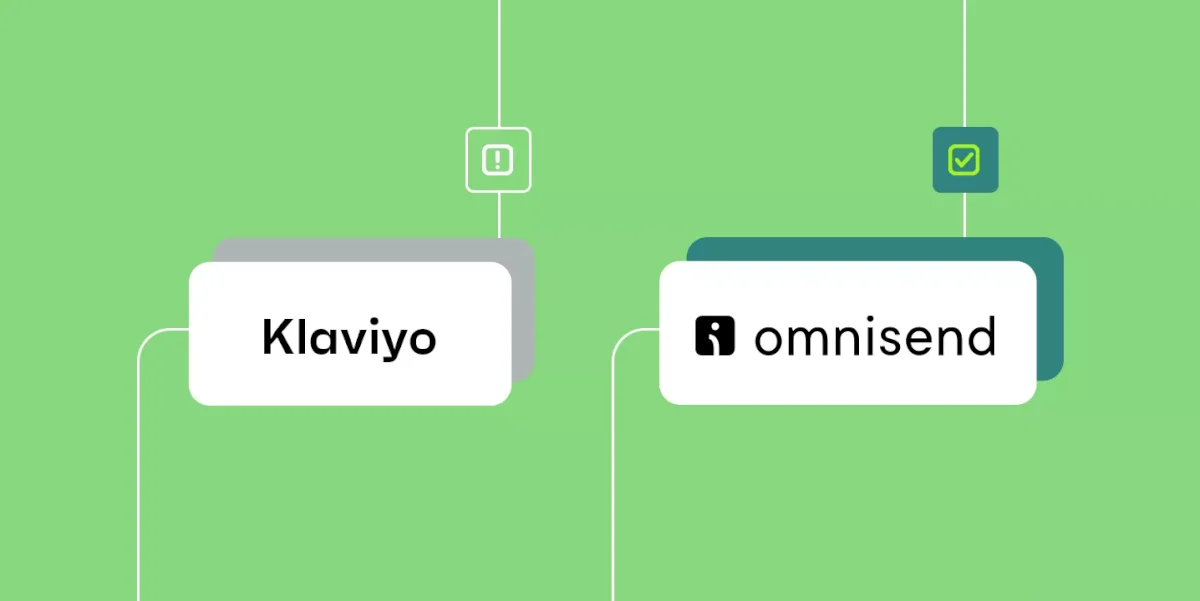Reading Time: 38 minutes
Comparing Omnisend vs. Klaviyo reveals some surprising findings. It’s clear that Omnisend is more cost-effective and offers multichannel marketing capabilities regardless of the plan you choose, but where they really differ is in depth versus speed.
Klaviyo gives you more segmentation and customer data insights if you need them. Omnisend gets you started faster with fewer decisions along the way. You might favor the extra control or Omnisend’s immediately useful features.
Both platforms earn excellent ratings across review sites. Omnisend edges ahead on Shopify’s app store, while they tie on G2 at 4.6 stars.
Which email tool best suits your ecommerce store? This article provides a comprehensive and unbiased comparison of Klaviyo vs. Omnisend to help you choose the best email marketing app.
Omnisend vs. Klaviyo in a nutshell:
Omnisend works for ecommerce stores of all sizes that want email and SMS marketing without the learning curve. Set up campaigns quickly, pay less monthly, and still reach customers via email and text.
Klaviyo suits teams ready to invest time mastering advanced features. You’ll pay more but gain granular control over every customer touchpoint.
Join Omnisend to grow your email and SMS marketing sales without feature restrictions
Quick sign up | No credit card required
Quick comparison: Klaviyo vs. Omnisend at a glance
The infographic below provides a snapshot comparison between Klaviyo vs. Omnisend, including their features, ratings, and pricing:
Pros and cons
Omnisend
Pros
- Omnichannel capabilities in all plans
- More affordable
- Suitable for ecommerce stores of all sizes
- Unrestricted AI features
- 24/7 support in all plans
Cons
- Fewer integrations
- Less advanced CRM features
Klaviyo
Pros
- Advanced segmentation
- Lots of customer data insights
- Detailed reports
- Built-in CRM
Cons
- Expensive at higher sending volumes
- Steeper learning curve
- Limited multichannel features in free plans
- Marketing analytics requires a separate plan
Ratings
- Omnisend 4.8/5
- Klaviyo 4.7/5
G2
- 4.6/5 for both
Trustpilot
- Omnisend 4.3/5
- Klaviyo 2.1/5
Feature comparison
Channels and messaging
- Email – tick for both
- Push notifications – tick for both
- SMS in all plans – tick Omnisend only
Automation and ecommerce
- Pre-built flows – tick for both
- Automation builders – tick for both
- Revenue attribution – tick for both
Templates and design
- Generative AI in all plans – tick Omnisend only
- Pre-built email designs – tick for both
- Form and popup templates – tick for both
Segmentation
- AI segment builder in all plans – tick Omnisend only
- Pre-built segments – tick for both
- Unlimited segments – tick for both
Integrations
- Shopify, BigCommerce, WooCommerce, Wix, Squarespace logos for both
- Omnisend – 160+ integrations
- Klaviyo – 350+ integrations
Pricing
Omnisend
- Free, 250 contacts, 500 emails/month
- Standard: $16/month, 500 contacts, 6k emails/month
- Pro: $59/month, 2,500 contacts, unlimited emails/month, bonus SMS credits equal to the price of your monthly plan
Klaviyo
- Free: 250 active profiles, 500 emails/month
- Email: $20/month, 500 emails/month
- Email + mobile messages: $35/month, 5,000 emails, 1,250 SMS credits
Read on to find out more about Omnisend and Klaviyo in our email marketing platform comparison below.
Klaviyo vs. Omnisend pricing: Which platform fits your business size
Let’s jump straight into an Omnisend vs. Klaviyo pricing comparison for different businesses:
Small and emerging businesses
If you’re a small or emerging business, then your contact list will be fewer than 250. At this stage, Omnisend vs. Klaviyo offer identical list size and send limits in their free plans, but only Omnisend gives you access to multichannel segmentation features.
Klaviyo’s free plan
250 contacts and 500 monthly email sends. Features include:
- Email campaigns and automations
- 150 SMS credits/month
- Segmentation and forms
- Email support (first 60 days only)
- Built-in reporting dashboards
Omnisend’s free plan
Omnisend matches the 250 contacts and 500 email sends in Klaviyo’s free plan, plus includes:
- 500 web push notifications
- SMS messaging ($1 free credit to try)
- Unlimited segments
- 24/7 live chat and email support
- Access to all AI features, including an AI segment builder
The verdict
Omnisend’s free plan offers unrestricted standard features and allows you to combine email and SMS channels into seamless flows. It’s the best-fit tool if you’re starting, have a contact list of under 250, and want an intuitive tool that’ll have you up and running quickly.
Medium and growth-focused companies
We’ll preface this part by saying that neither Omnisend nor Klaviyo’s free plans are suitable for more than 250 contacts. You need to compare Klaviyo vs. Omnisend pricing across paid plans if your list exceeds that or is expected to outgrow it anytime soon.
Here’s a breakdown of pricing per 1,000 and 5,000 contacts:
Klaviyo’s paid plans
Klaviyo offers two paid plans. Each builds on the free plan’s features:
Email plan
Adds generative AI for content creation, but restricts multichannel segmentation, A/B testing, and attribution, rendering SMS a standalone channel.
Pricing
- 1,000 contacts: $30/month
- 5,000 contacts: $100/month
Email + mobile messages plan
All these plans include bonus SMS credits, the multichannel features described above, and SMS smart opt-in for compliance.
Pricing
- 1,000 contacts: $45/month
- 5,000 contacts: $115/month
Omnisend’s paid plans
Omnisend offers two paid plans, both of which are more affordable than Klaviyo’s and include multichannel capabilities as standard, making email and SMS complementary channels. Its Pro plan includes bonus SMS credits equal to the price of your monthly plan.
Pricing
Standard plan:
- 1,000 contacts: $20/month
- 5,000 contacts: $81/month
Pro plan:
- 1,000 contacts: $59/month
- 5,000 contacts: $90/month
The verdict
Omnisend costs $20 or $59/month for 1,000 contacts and $81 or $90/month for 5,000 contacts. If you’re a medium-sized business performing an Omnisend vs. Klaviyo comparison, Omnisend offers better value.
Large and enterprise businesses
Let’s compare each tool’s pricing per 10,000 and 50,000 contacts:
Klaviyo pricing
Email plan
- 10,000 contacts: $150/month
- 50,000 contacts: $720/month
Email + mobile messages plan
- 10,000 contacts: $165/month
- 50,000 contacts: $735/month
Omnisend pricing
Standard plan
- 10,000 contacts: $132/month
- 50,000 contacts: $413/month
Pro plan
- 10,000 contacts: $150/month
- 50,000 contacts: $715/month
The verdict
It’s close, but Omnisend offers monthly savings from $15 to $20/month for 10,000 and 50,000 contacts. Sending SMS can also be more cost-effective, as it includes bonus SMS credits equal to your monthly plan.
Final takeaway
Klaviyo is more expensive than Omnisend across all plans, and its most affordable options limit the multichannel features necessary for ecommerce. If you want all standard features from the free plan upwards, Omnisend is your best choice.
Check out the infographic below for a visual pricing comparison:

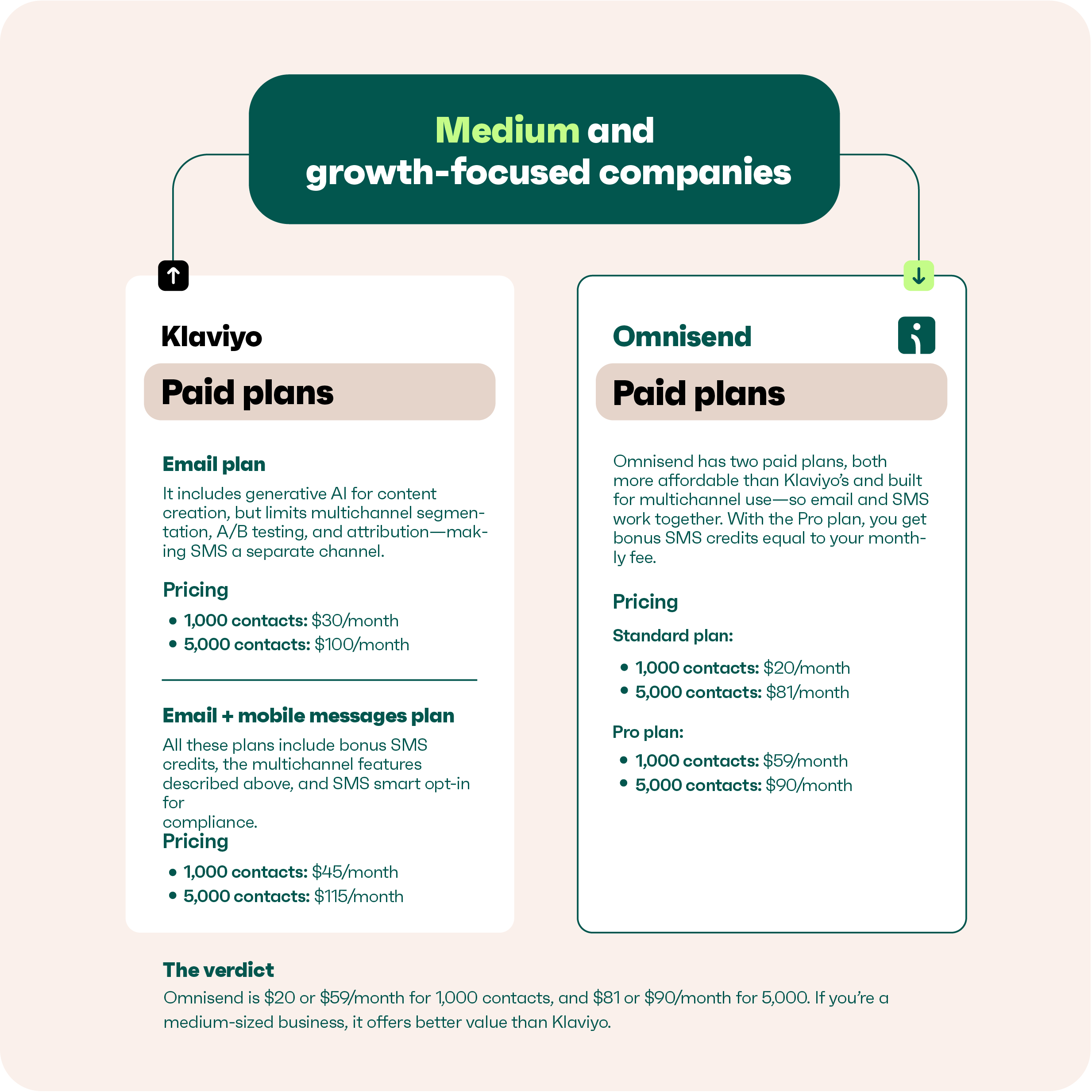

Quick email provider pricing comparison
Quickly and easily compare the top email marketing providers so you can find the best platform for your ecommerce store needs.
Compare
prices for:
You can compare Omnisend and 2 more providers at once.
- Omnisend
- Klaviyo
- Mailchimp
- Drip
- Moosend
- Active Campaign
- Get Response GetResponse
- MailerLite
You can compare Omnisend and 2 more providers at once.
Select at least one provider.
Free
Tier 1
Tier 2
Tier 3
Still not sure?
Try out the full version of this calculator
Is Klaviyo or Omnisend easier to use?
Omnisend gets you started with ecommerce email marketing with fewer steps for most features. It also has generative AI across all plans to make your job easier. A prime example is its AI segment builder, which automatically creates a segment for you with a single prompt. Here’s an example:
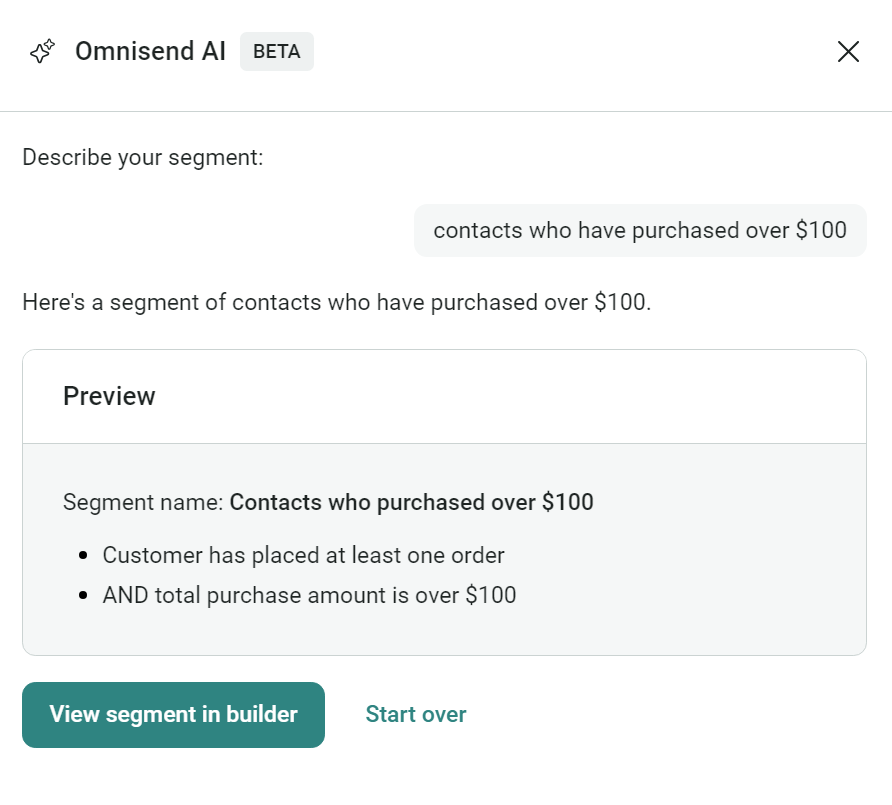
What you need to know:
Initial setup and onboarding
You can set up either Omnisend or Klaviyo in about five steps. No credit card needed for free accounts. Both connect to Shopify, WooCommerce, BigCommerce, Wix, and other major ecommerce platforms via apps.
With either platform, you can create an account first or install the app first and then create an account, so the order you do it in doesn’t matter whatsoever. The most common approach is to create an account first so that any app or plugin you use is ready to go.
The image below shows Klaviyo’s Shopify integration dashboard, accessed via the Integrations menu and by searching for Shopify:
Add your Shopify store URL, click Connect to Shopify, and Klaviyo then redirects you to Shopify and prompts you to install its app if you’re logged in:
Omnisend takes a slightly different approach. During sign up, if you pick your ecommerce platform, the dashboard loads with a prompt to connect to whichever you chose, as below:

Selecting Connect to Shopify redirects you to the Shopify App Store to install it and complete the setup. It takes a maximum of five minutes to link everything, and you receive a similar prompt if you use WooCommerce or another platform.
Winner
Draw. Klaviyo and Omnisend both have decent onboarding experiences. We have no complaints, with both approaches taking little time. Additionally, there’s no clear distinction between Klaviyo and Omnisend for Shopify, as both utilize third-party dashboards.
Dashboard and navigation
Klaviyo’s dashboard has right-sided navigation with a helpful Get started item at the top, which you can use to jump into the following steps, like creating a form or flow:
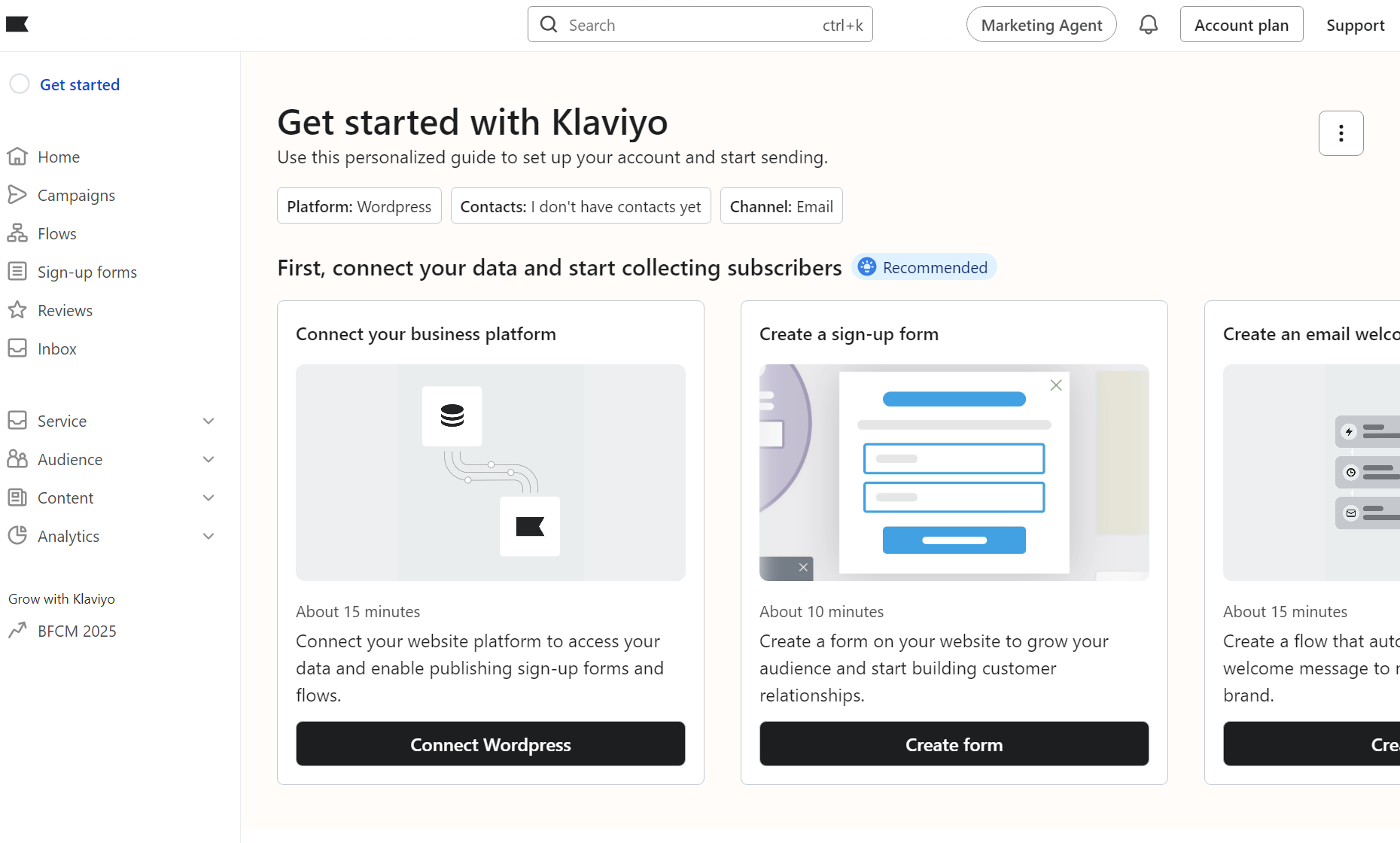
What’s impressive here is the amount of detail Klaviyo goes into to explain everything with descriptions and steps. If you’re a complete beginner to ecommerce email marketing, you’ll feel at home and won’t take any steps too far too soon.
In comparison, Omnisend’s dashboard is even more helpful, with a step-by-step guide that shows your progress from connecting your store to setting a brand style:
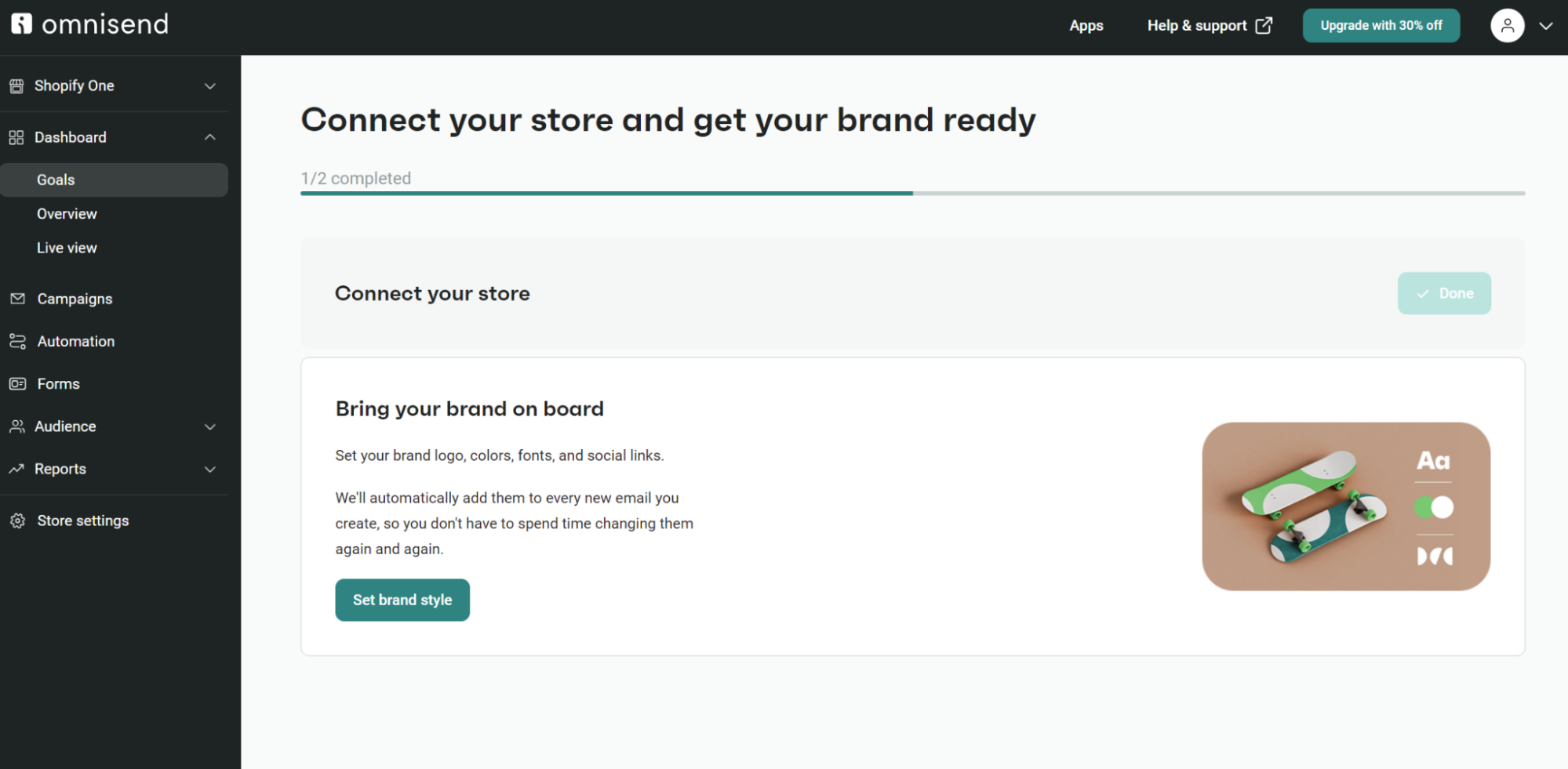
The point here is that Omnisend gets you started immediately with elements that will impact your email marketing campaigns (branding), and once you complete that step, you get the option to create a workflow.
Like Klaviyo, Omnisend has right-sided navigation, but it has a more efficient layout and a black background, which you’ll prefer if you usually use dark mode on your devices.
One element both platforms share is speedy load times. You won’t be left waiting for pages to load for ages. It’s all practically instantaneous (although you still need a decent internet connection).
Winner
In this Klaviyo vs. Omnisend comparison, Omnisend emerges as the winner. It gets you started as quickly as possible with steps to add branding and create campaigns. Klaviyo is easy to master, too, but finding what you need at first isn’t as easy.
Creating your first campaign
Omnisend offers a more progressive campaign-building experience, with a clear separation between campaign types from the start and breadcrumbs for returning to multiple sections. However, that doesn’t mean it’s any easier. In fact, both tools are on par in many respects.
Let’s review the steps:
Creating a campaign Omnisend
- Navigate to Campaigns:
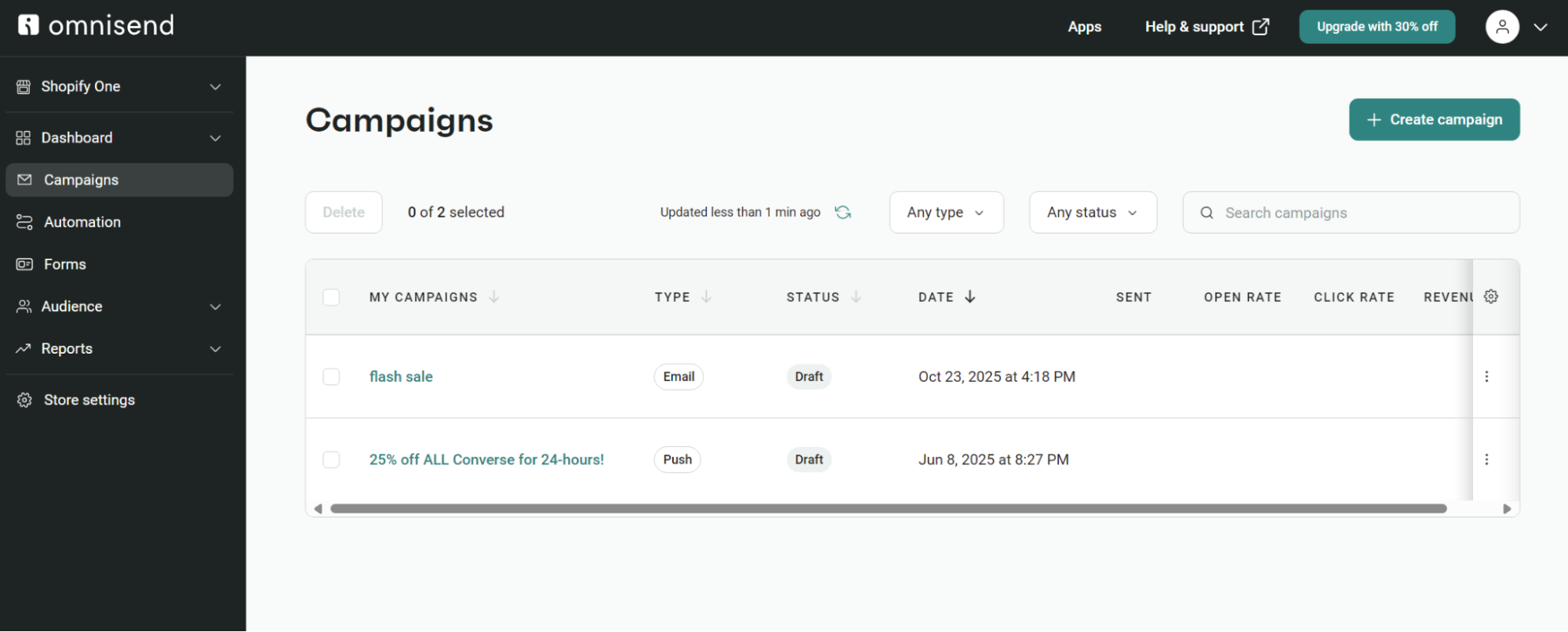
- Select + Create campaign
- Pick a campaign type:
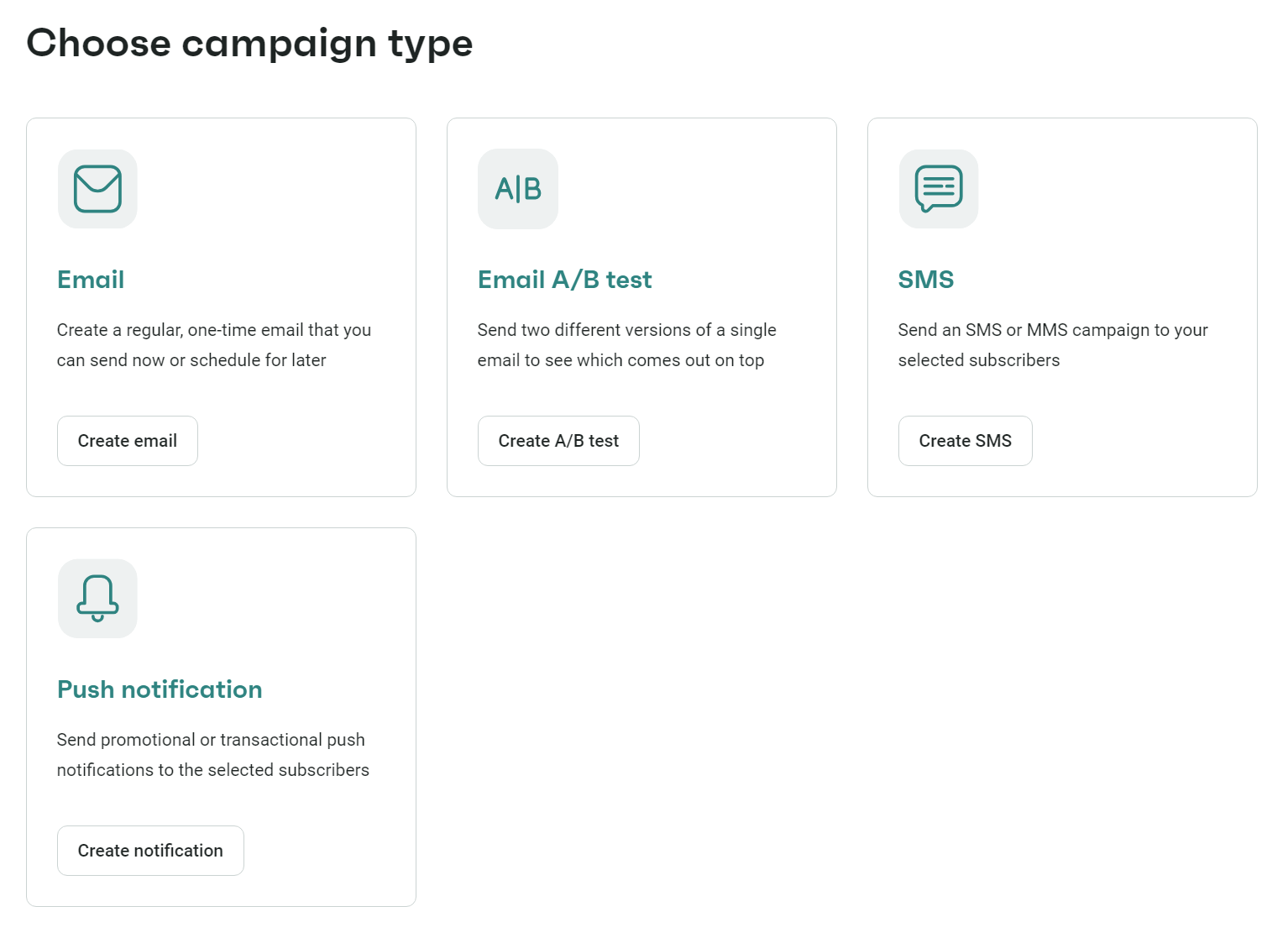
- Add your campaign details (for example, subject line, content)
- Pick a pre-built template:

- Edit the template
- Save and choose your recipients
- Review the campaign
- Activate Campaign booster to resend to subscribers who miss it automatically:
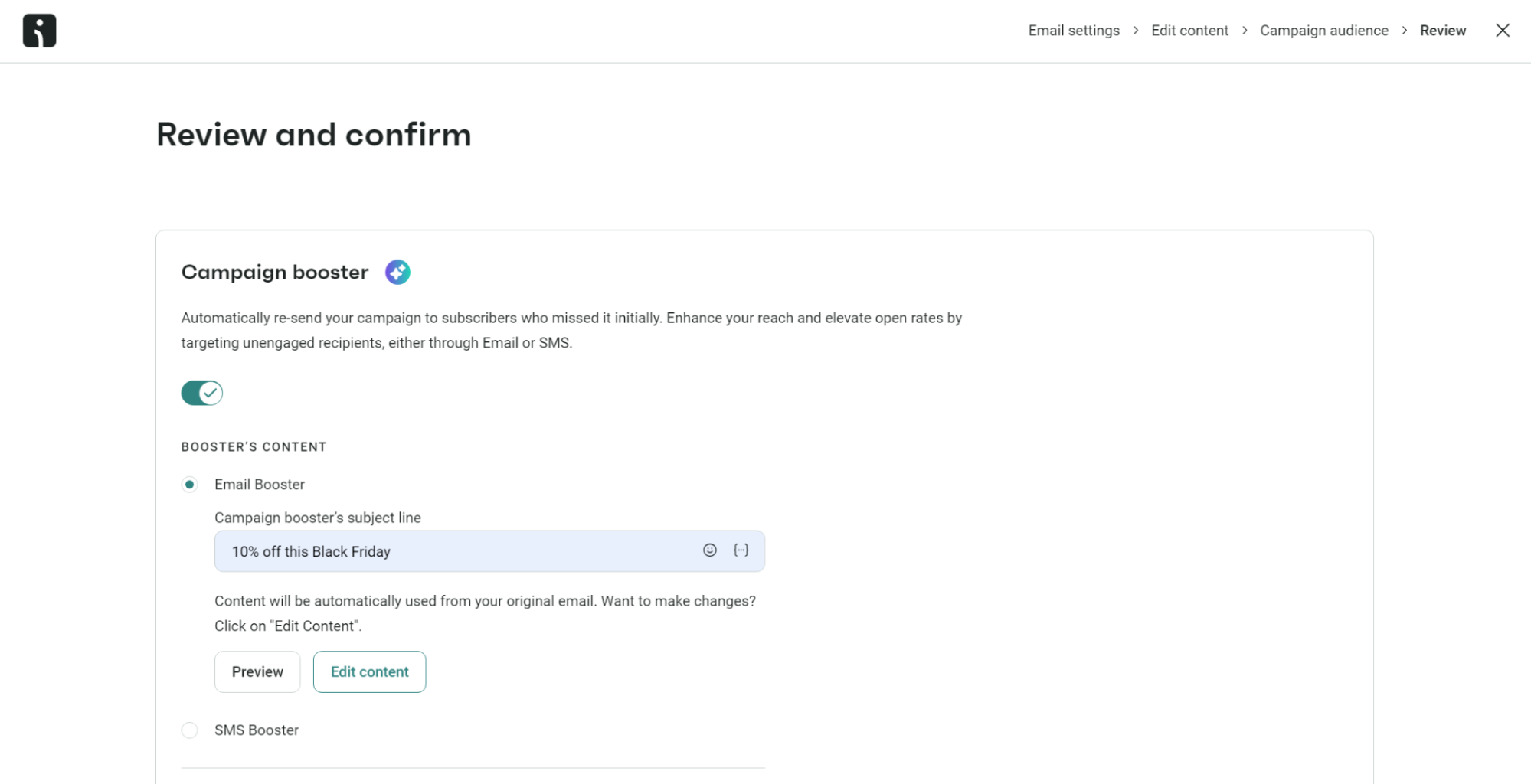
- Send the campaign now or schedule it for later
Creating a campaign in Klaviyo
- Navigate to Campaigns
- Select Create campaign
- Pick omnichannel or single channel:

- Select your channel (if picking a single channel)
- Choose your audience, defined as a list or segment:

- Enter your email subject line, preview text, and other details
- Select a template from the email library:
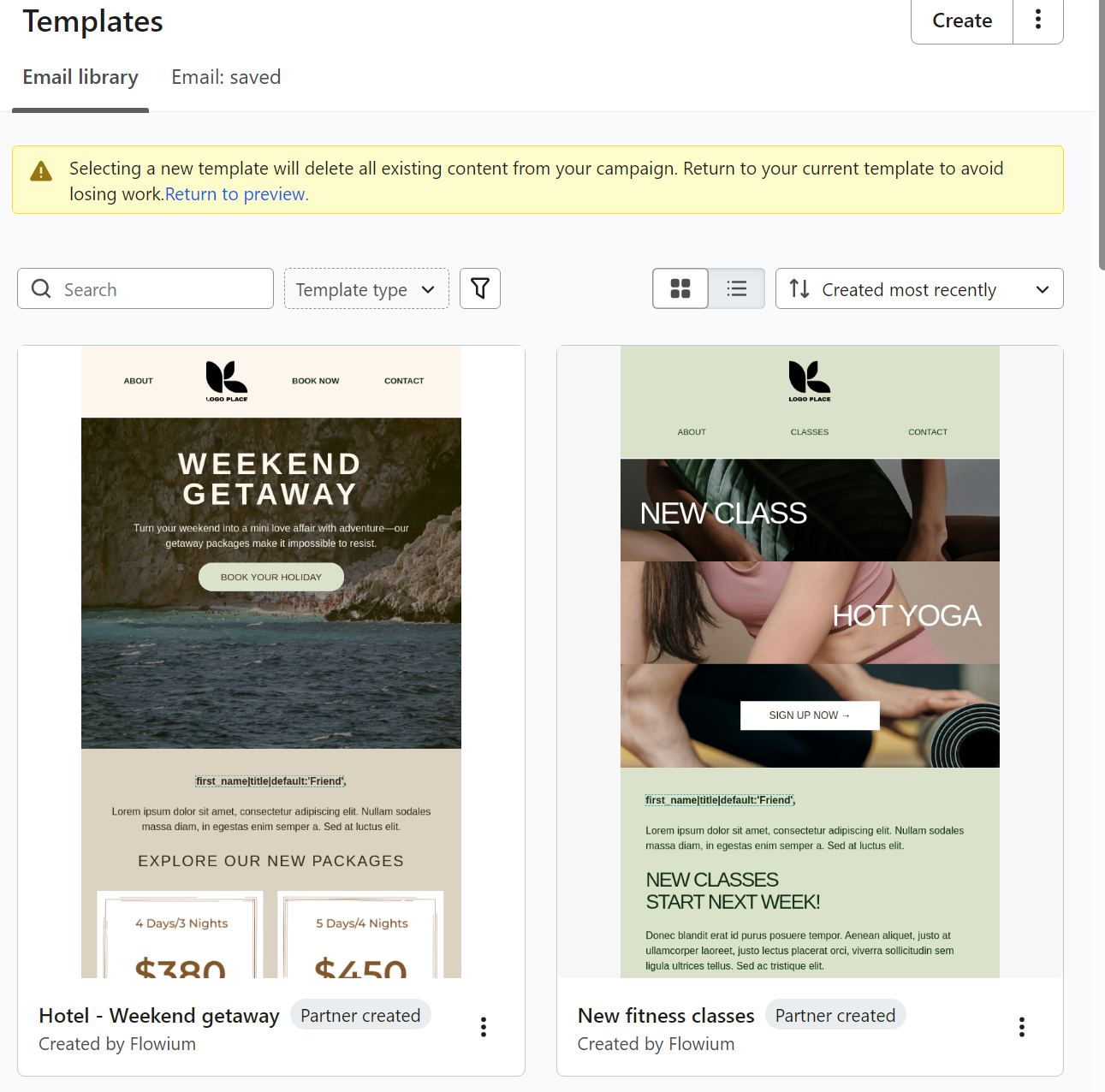
- Edit the template to your liking
- Preview your campaign
- Click schedule or send to complete your campaign:

Winner
Omnisend because it has fewer loadable steps. Both tools guide you through creating your first email campaign, and there’s little that can go wrong with either tool.
Which platform has better email templates?
Omnisend offers 250+ email templates, while Klaviyo offers 160+. The quality of templates in both is fantastic, and all of them are mobile-friendly. However, Omnisend has the edge with significantly more seasonal and themed templates, allowing you to run unique campaigns.
Template libraries compared
Klaviyo’s template library is difficult to access from the backend. You need to start creating a campaign, and when on the Message screen (step two), click the three dots and then select the Email library. Here’s a screenshot of the list view:

The list view is the best way to navigate multiple templates in Klaviyo because it shows significantly more on your screen. The grid view provides a better visual once you find any templates that interest you:
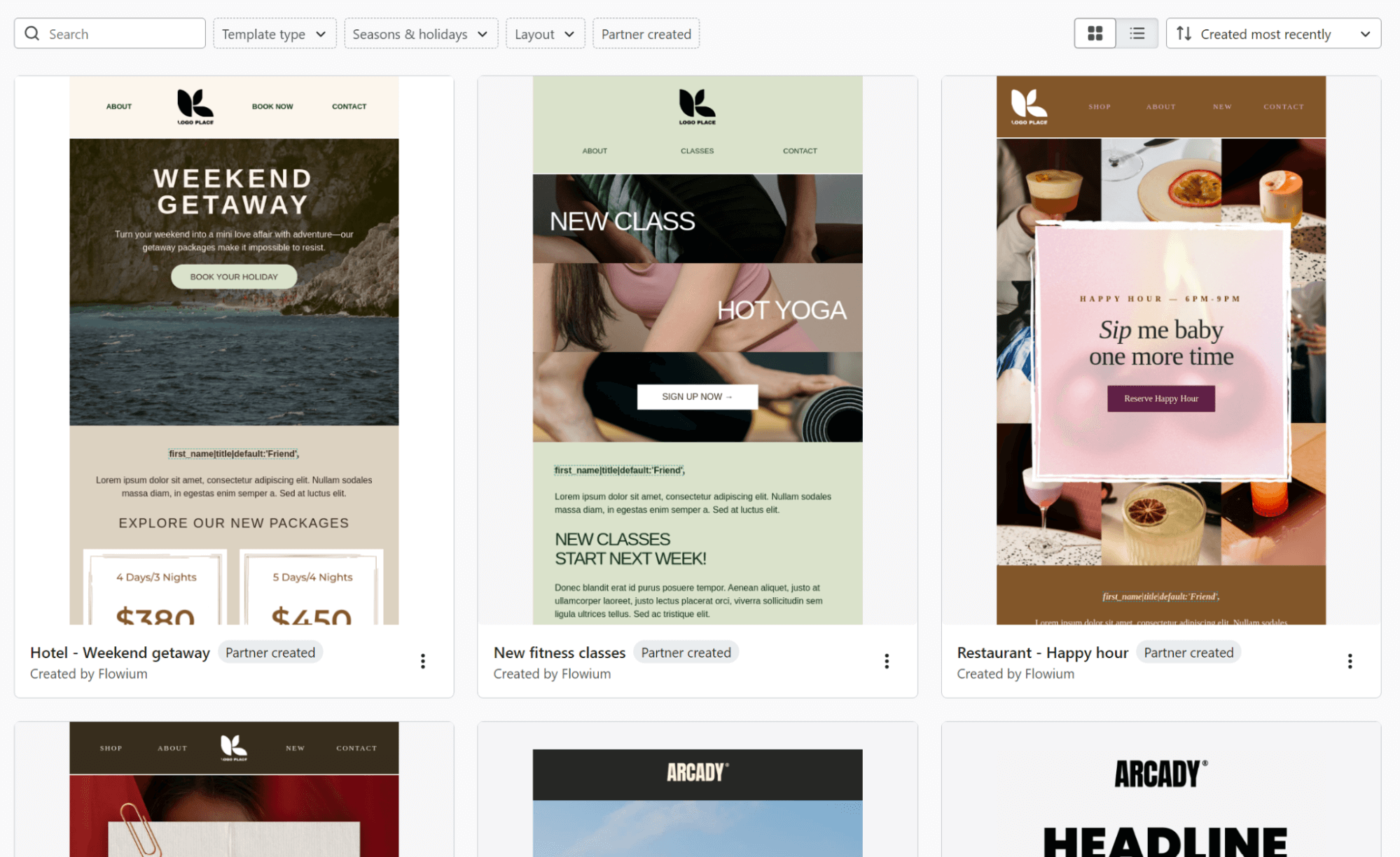
You can use the search field to discover email templates by theme and sort them by alphabetical order or by editing and creation date.
Omnisend’s template library is easier to access than Klaviyo’s, and the stock layout is more logical. Create a campaign, enter your email settings, and the next step is to choose a template:

Seasonal templates appear at the top of the email library in a recommended section, and you can filter all templates by goal, theme, and type. Additionally, if you save templates, they appear in their own tab.
Winner
Omnisend, because its email template library offers significantly more choice (250+ vs. 160+), and the designs feel more unique.
Drag-and-drop differences compared
Both Klaviyo and Omnisend have drag-and-drop email builders. These provide blocks (or elements) that require no coding to look perfect.
Omnisend’s drag-and-drop editor has two sidebars on the left and right, with the right-hand one loading settings for any element you drag in:
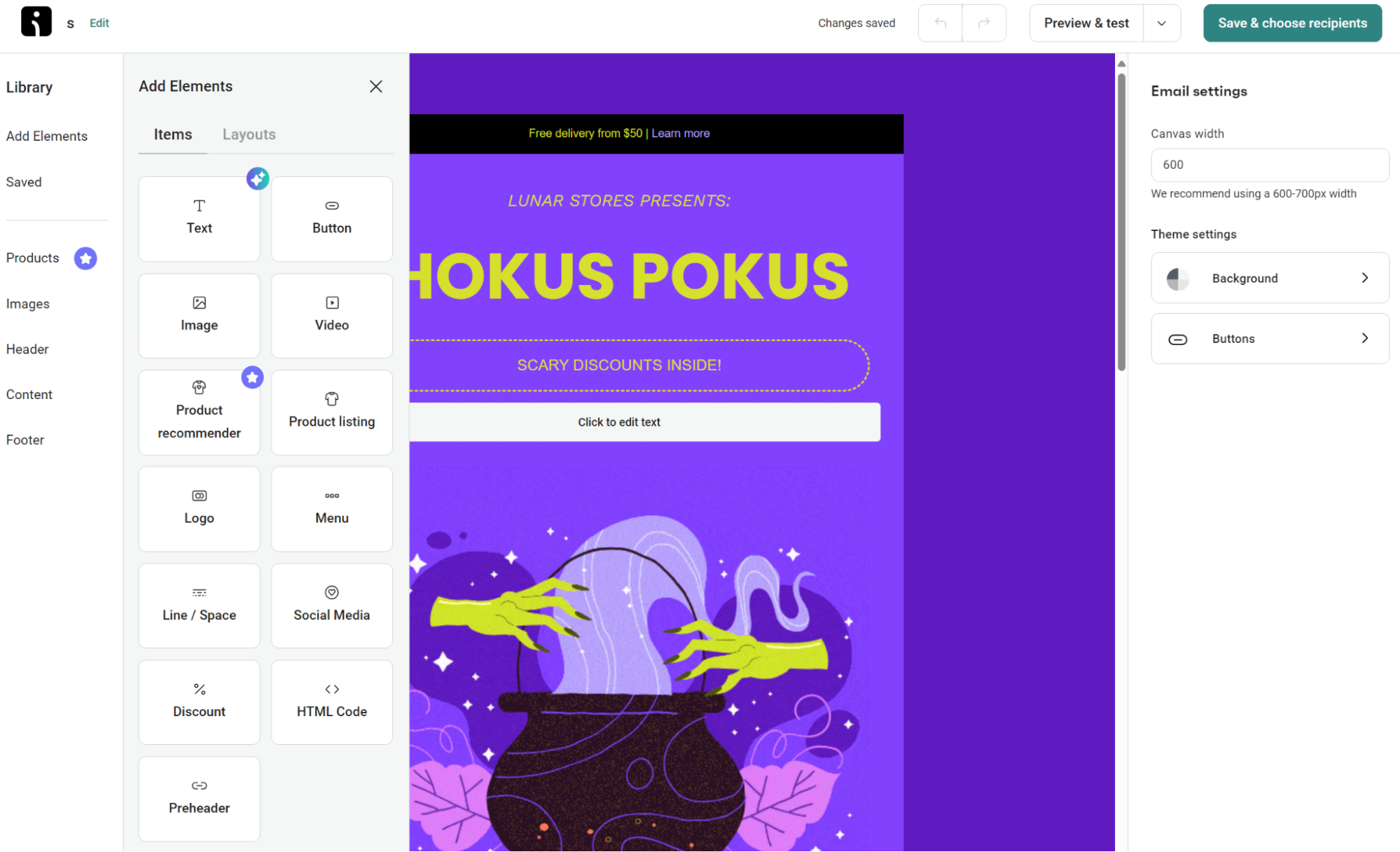
The elements cover text, buttons, images, videos, product listings and recommendations, logos, menus, social media, and more.
One superior aspect of Omnisend’s drag-and-drop builder is its standard layout options, which include six layouts versus Klaviyo’s two:

Because Omnisend provides generative AI features across all plans, even if you’re a free customer, you can use its AI to modify text within your template builder. For example, the text block provides this prompt when using the AI feature:
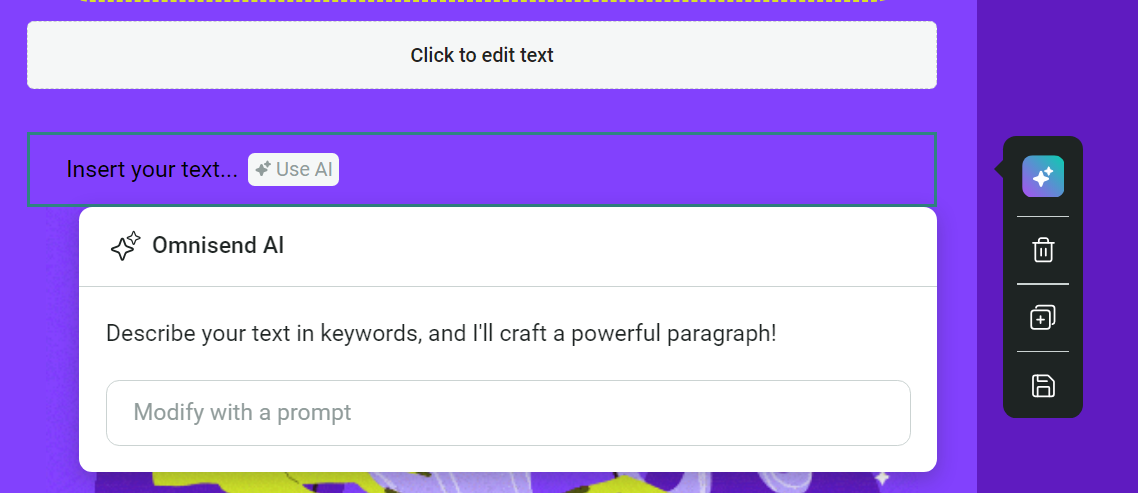
Its combination of intuitive elements, advanced settings, and AI features makes it one of the best email editors on the market, let alone in comparison to Klaviyo.
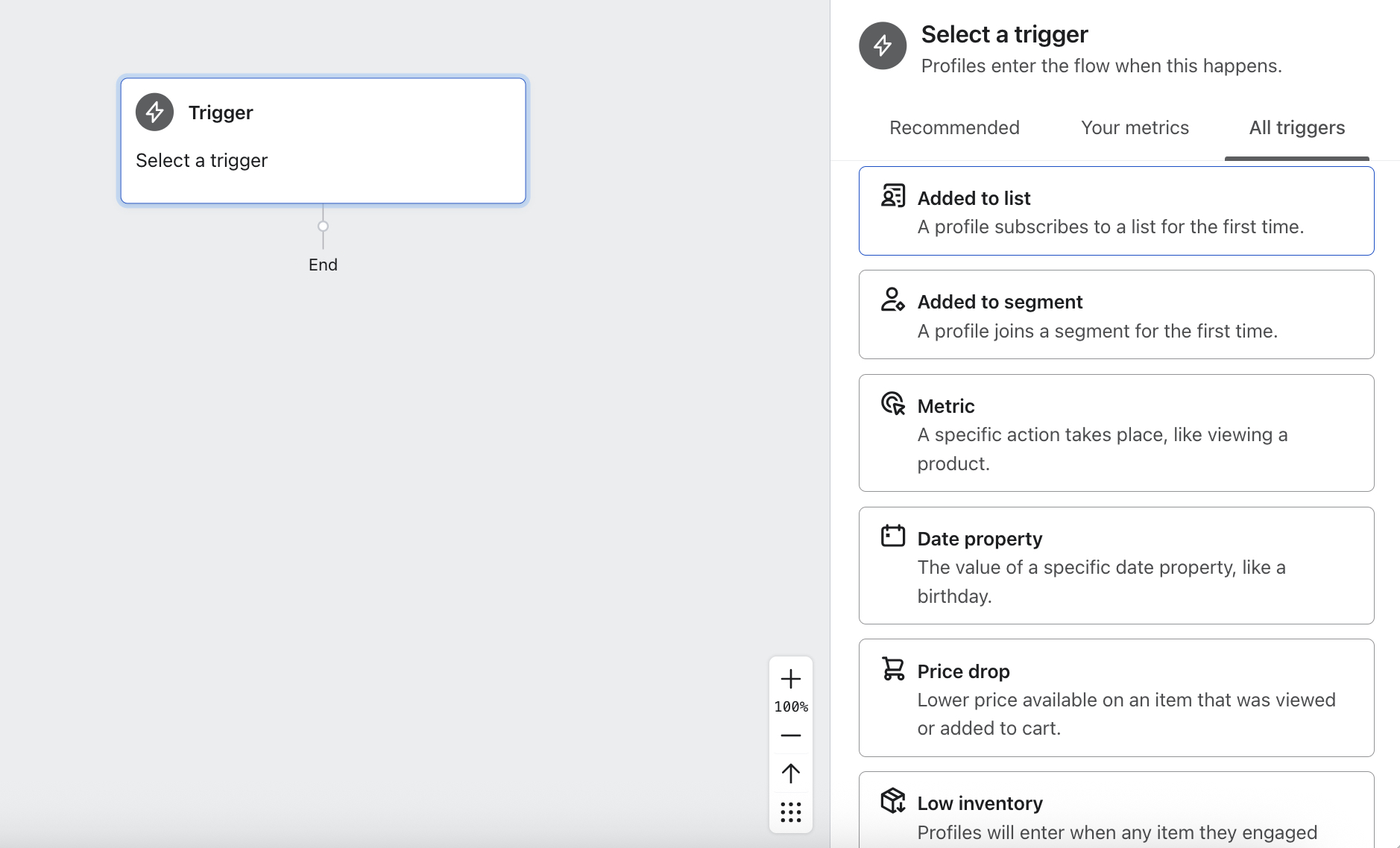
Klaviyo’s drag-and-drop editor is equally pleasant. It loads with basic blocks available in the sidebar and tabs for pre-built and universal (reusable) blocks. There aren’t any glitches dragging these across, and everything appears as it should.
One thing that is great about Klaviyo’s email editor is that it has more design elements than Omnisend. For example, there are blocks for a drop shadow, table, and split, allowing you to create more dynamic emails without prior design experience.
Winner
Draw. Klaviyo has more elements (which it calls blocks), but Omnisend has significantly more standard layouts (six versus two) and AI features.
A/B testing
Omnisend’s A/B testing allows you to test subject lines, sender names, email addresses, and content before sending them to your entire list. Head to Campaigns > + Create campaign > and select Email A/B test to set one up:
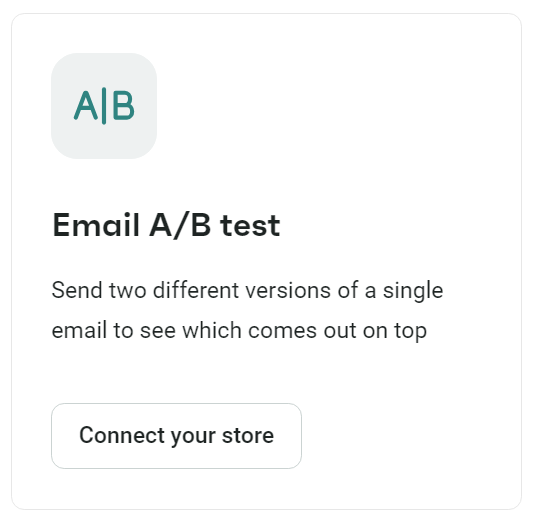
The Settings page provides a split-view for subject lines, preheaders, sender name, and sender email address with a preview:

Once you’ve completed that page, you can create your templates.
You choose the percentage of contacts that receive version A versus B, and then Omnisend tracks opens or clicks for one to 24 hours. The winner automatically goes to everyone else.
Tests work with as few as 10 contacts, but you’ll want thousands for meaningful data. Reports show you the numbers behind each version’s performance, as well as any revenue differences.
Klaviyo’s A/B testing covers the same ground as Omnisend. You split your audience, test different versions, and the winner is shared with everyone else.
Free accounts include A/B testing, but multichannel A/B testing is restricted to its top-tier email and mobile messages plan, and only paid accounts receive AI-generated subject line variations.
To set up an A/B test in Klaviyo, you create a campaign and select Create A/B test, which is a button that sits above the Email message section:

The A/B test setup page provides options to test content or test send time, and provides a detailed split-view of both email versions:
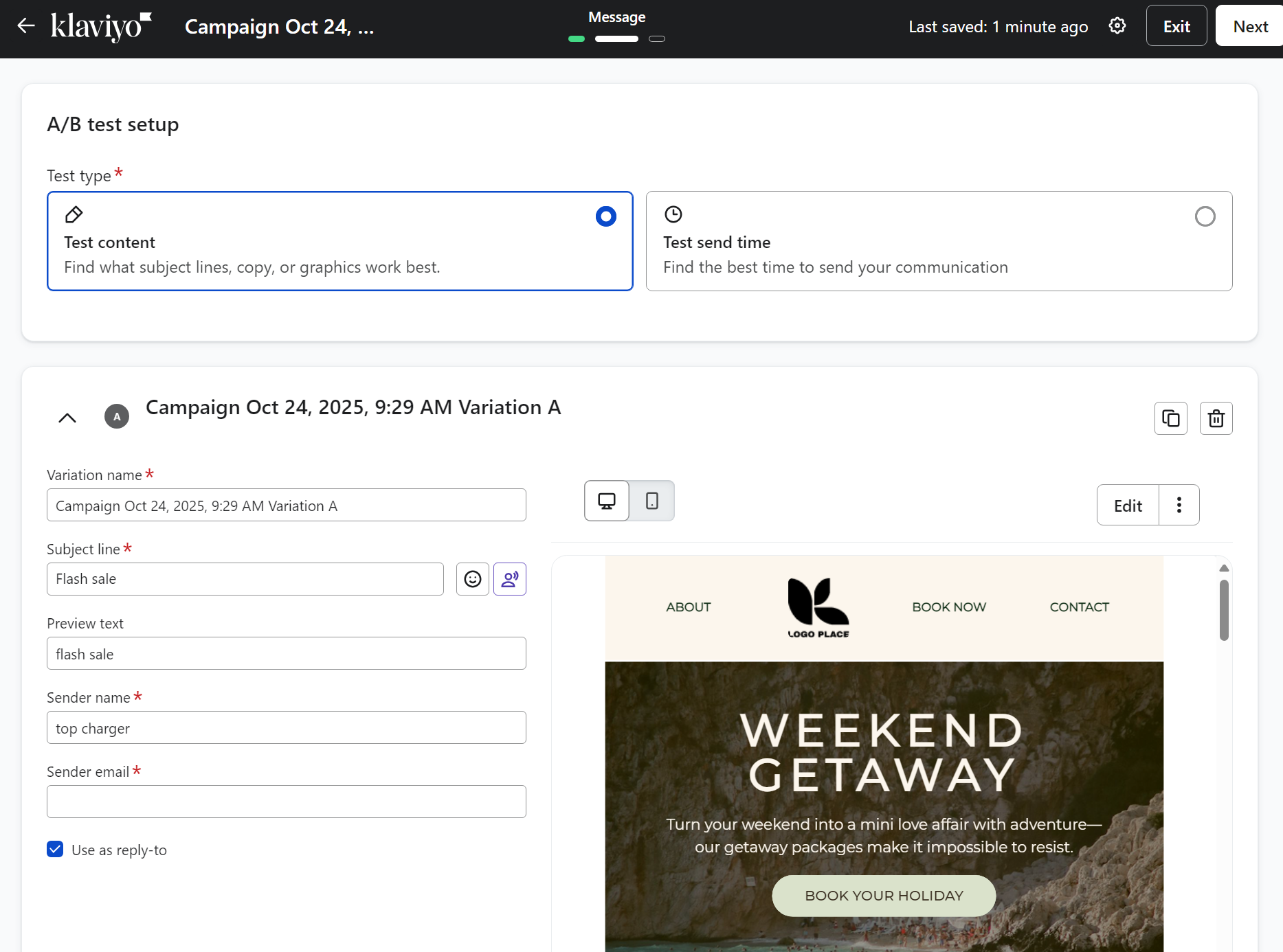
Accounts with 400,000+ profiles can send different versions to different people based on what Klaviyo knows about them. For example, one person might get the discount subject line while another receives the new product announcement, depending on their purchase history.
Winner
Omnisend. Its generative AI features make it easier to create winning subject lines, and it has a dedicated email A/B test campaign type for instant setup.
Ecommerce features
Adding products to your emails is simple with Omnisend and Klaviyo, using their draggable elements. However, Omnisend offers better options.
With Omnisend, you can add a product listing element that has three layout options and lets you add custom images for a perfect product display:
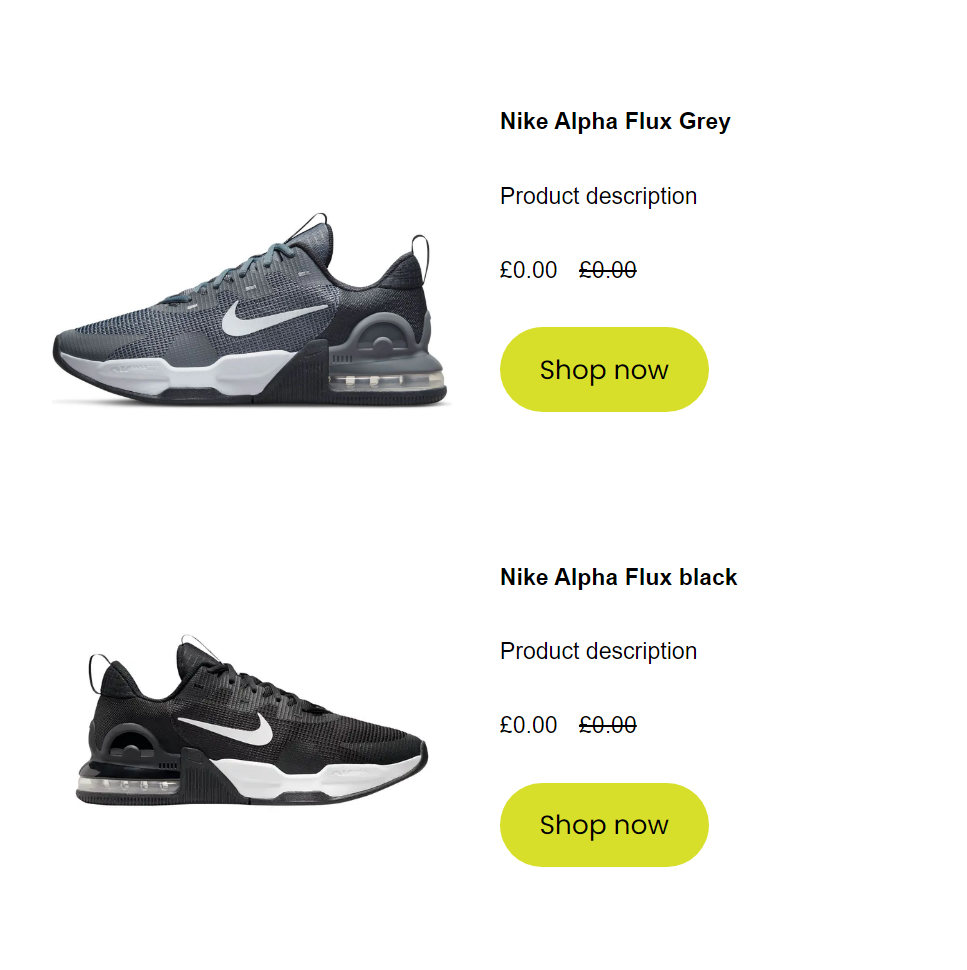
There’s also a Products tab in the sidebar with a slide-out menu, which provides multiple product display options linked to your product catalog:
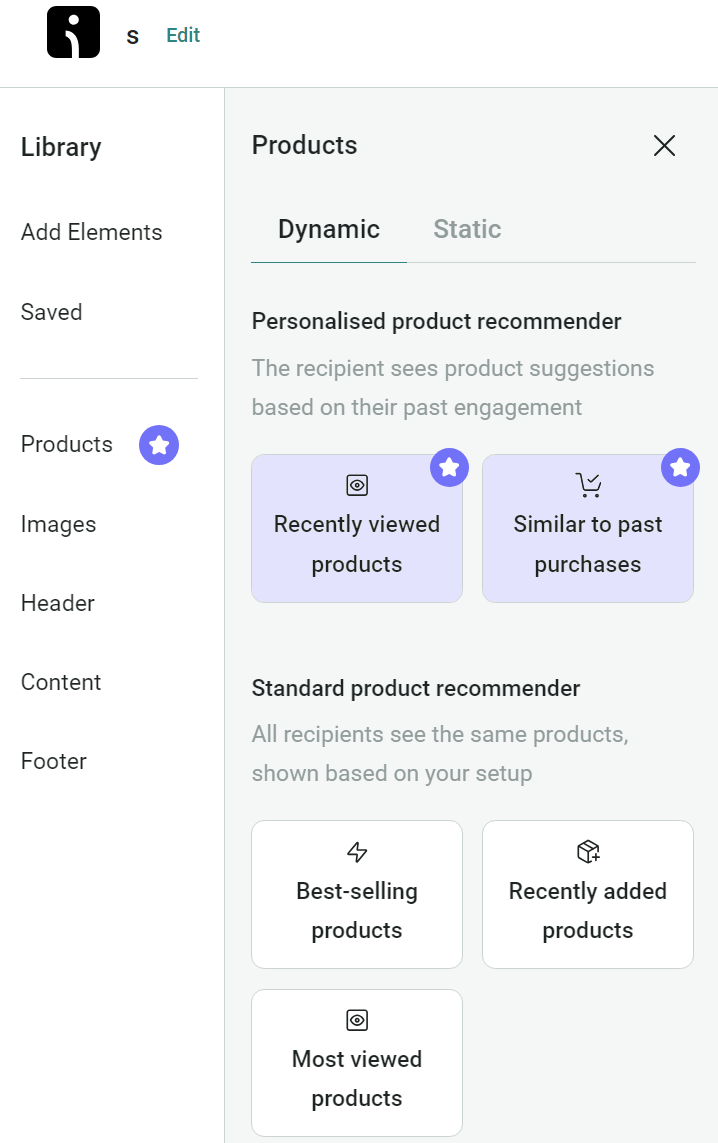
Recently viewed products and similar items to past purchases are part of its paid plans (an optional add-on for the Standard plan, and included in Pro). However, the best-selling products, recently added products, and most viewed products blocks are available in all plans.
Klaviyo’s product blocks drag into emails like any other block. You pick between dynamic feeds that update automatically (bestsellers, recently viewed, personalized picks) or manually selected products:
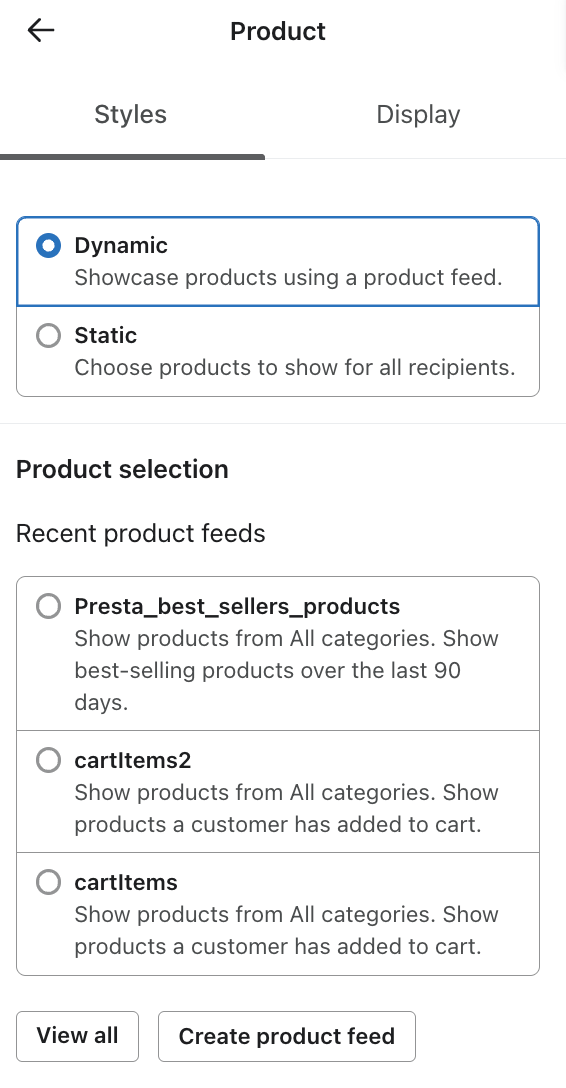
Dynamic feeds pull from your catalog based on rules you set, such as category, price range, and stock levels. Each feed can filter products and personalize what each recipient sees based on their browsing or purchase history:
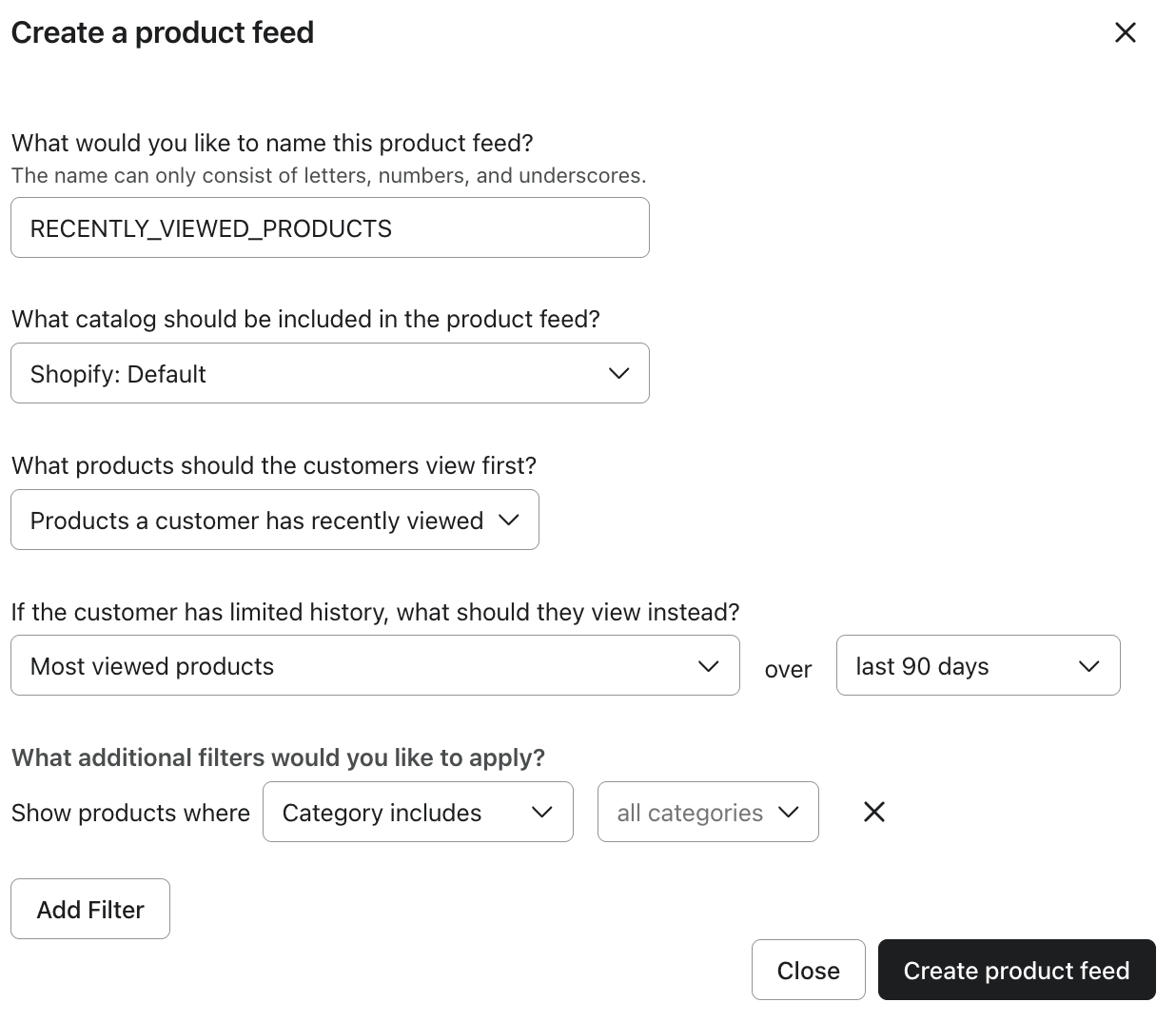
You control how many products are displayed (rows x columns), which details are shown (title, price, buttons), and all the styling.
The setup requires more clicks than with Omnisend, as you need to configure feeds separately from emails. However, you gain more control over what customers see.
Winner
Draw. Omnisend’s product blocks are easier to configure, but Klaviyo offers more granular control over product recommendations if needed.
Omnisend vs. Klaviyo: Which better grows subscriber list
If you want your emails to be opened, clicked, and bring in sales, you need subscribers who are actually interested in your services, not the ones who just opted in solely to receive a one-time offer.
Once you’ve created your ideal subscriber list, you must keep it clean and organized, because a messy list is just as ineffective as a dead list.
Both Omnisend and Klaviyo can help with that, but they go about it slightly differently.
Here’s a closer look at how they handle email list building and management, and which one might be a better fit for you.
| Feature | Omnisend | Klaviyo |
|---|---|---|
| List import options | CSV, Excel, and direct integration with other platforms | Offers CSV import and API integration |
| Signup forms | Offers customizable popups, landing pages, and gamified forms | Includes embedded forms, popups, and customizable multistep forms |
| Audience growth tools | Integrated SMS, email, and web push notification tools with automation flows for follow-ups | Form teasers, email, and SMS capture, and social media targeting ads |
| Data management | Simplified tagging and segmentation | Data segmentation and extensive custom fields |
| List cleaning | Automated unsubscribes and duplicate removal | Engagement-based filters and bounce management |
The Klaviyo vs. Omnisend comparison in terms of subscriber list features reveals some similarities. For instance, both platforms allow you to import your subscriber lists via CSV or integrated apps.
But if you’re a bit more technical (or working with a dev team), Klaviyo gives you extra flexibility with its API integration. It enables you to customize and automate your import process extensively.
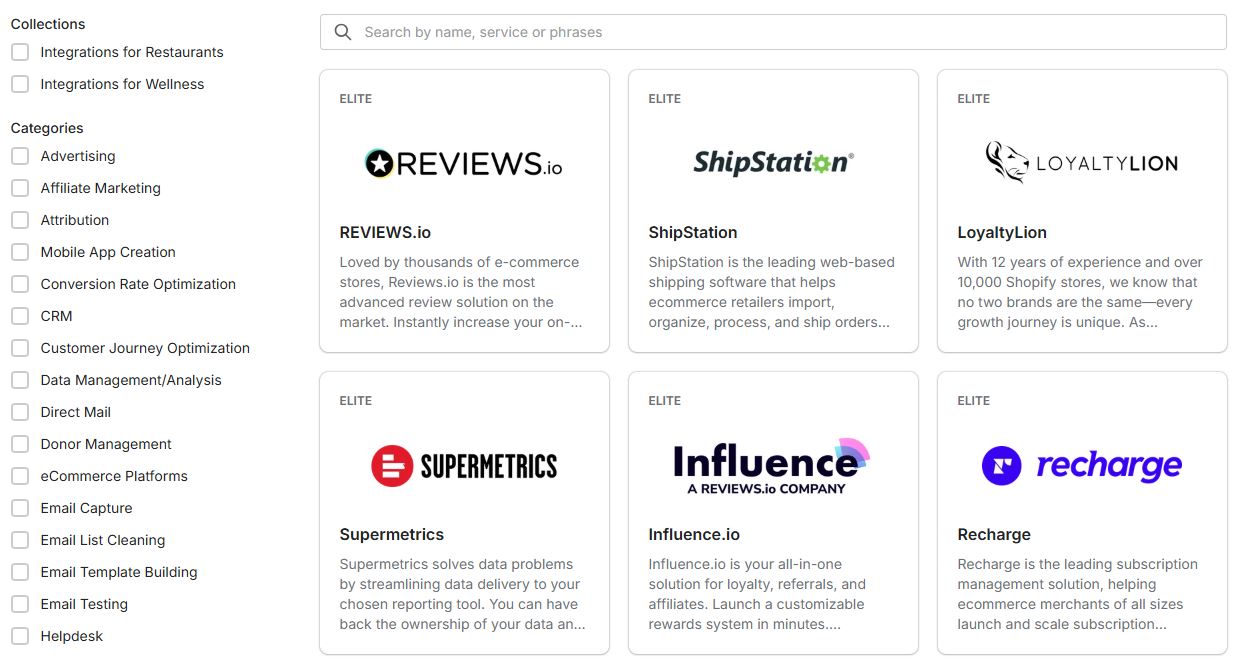
In terms of signup forms and audience growth, Omnisend and Klaviyo offer several practical tools, like popups. However, of the two platforms, only Omnisend generates landing pages.
So, if you’re launching something new, you can quickly create a dedicated page without making changes to your website.
Omnisend also offers a gamified Wheel of Fortune signup form that encourages customers to sign up, allowing them to spin for a discount.
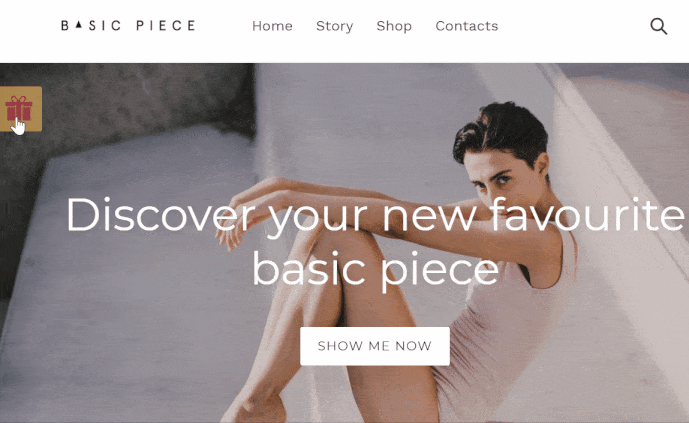
Winner
It’s pretty much a tie between Omnisend and Klaviyo for this round.
Which has better email automation: Omnisend or Klaviyo?
2% of total email volume accounted for an incredible 37% of all email-driven sales in 2024. What do all the 2% have in common? They were email automations.
Klaviyo’s automations can be more granular than Omnisend’s thanks to its advanced triggers for targeting different customer groups. However, Omnisend’s flows are faster to set up and cover most ecommerce scenarios without additional editing.
Pre-built flows and templates
Omnisend offers 27+ pre-built email and email + SMS flows covering the customer journey. You get welcome series, abandoned cart and checkout flows, browse abandonment with engagement splits, cross-sell with A/B delay testing, birthday flows, and transactional emails:
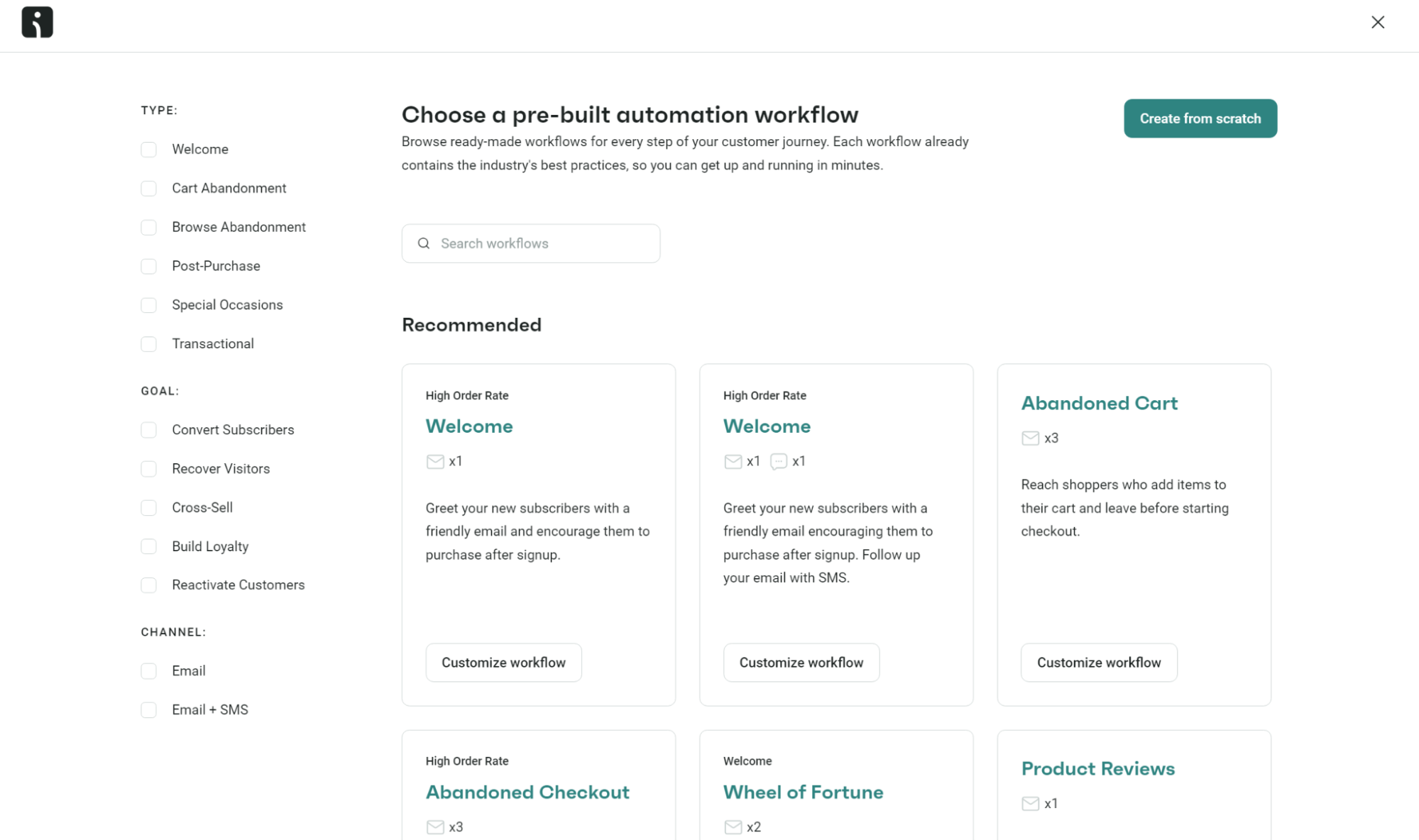
Dukier, a Madrid dog accessories brand, went from sending the same email to everyone to localizing automations across five languages. Revenue from Omnisend increased by 525% to €518,860, with automations alone accounting for 55% of that, resulting in minimal unsubscribes.
Replicating Dukier’s setup is simple. Each pre-built flow includes recommended timing, trigger filters, and message templates. The library categorizes them by goal (converting subscribers, recovering visitors, building loyalty) and by channel mix (email-only or email plus SMS).
Klaviyo advertises 60+ pre-built flow templates, including price drop alerts, back-in-stock notifications, and predicted next order flows:
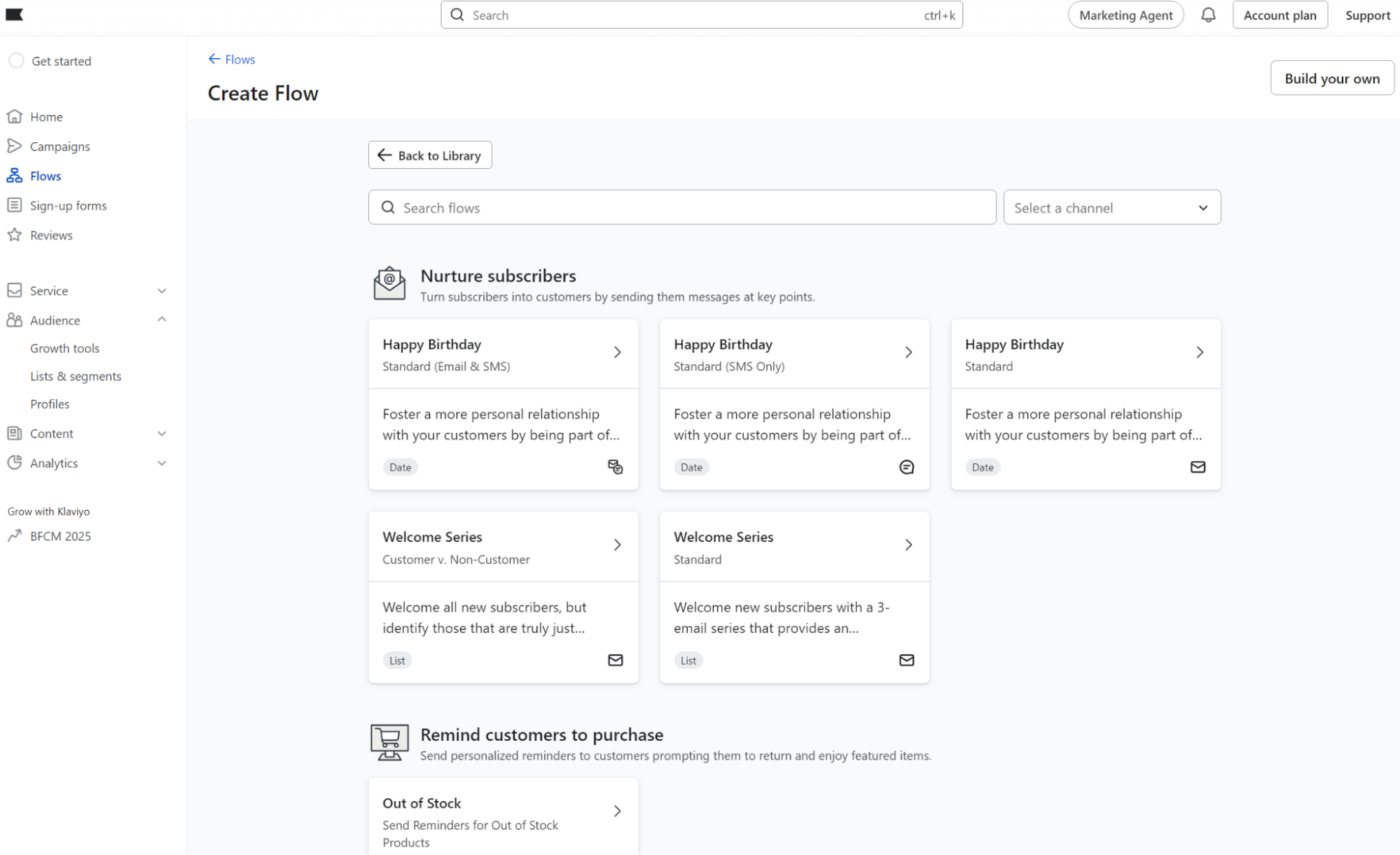
Each template automatically pulls dynamic data from your integration. The library allows you to filter by ecommerce platform if you want to view only compatible flows. You can also filter by channel to see which templates use email, SMS, or both.
Both Omnisend and Klaviyo make it easy to set up your first flow with pre-built templates, and that ease of use extends to building your own templates.
In Klaviyo, the template builder kicks off with triggers:
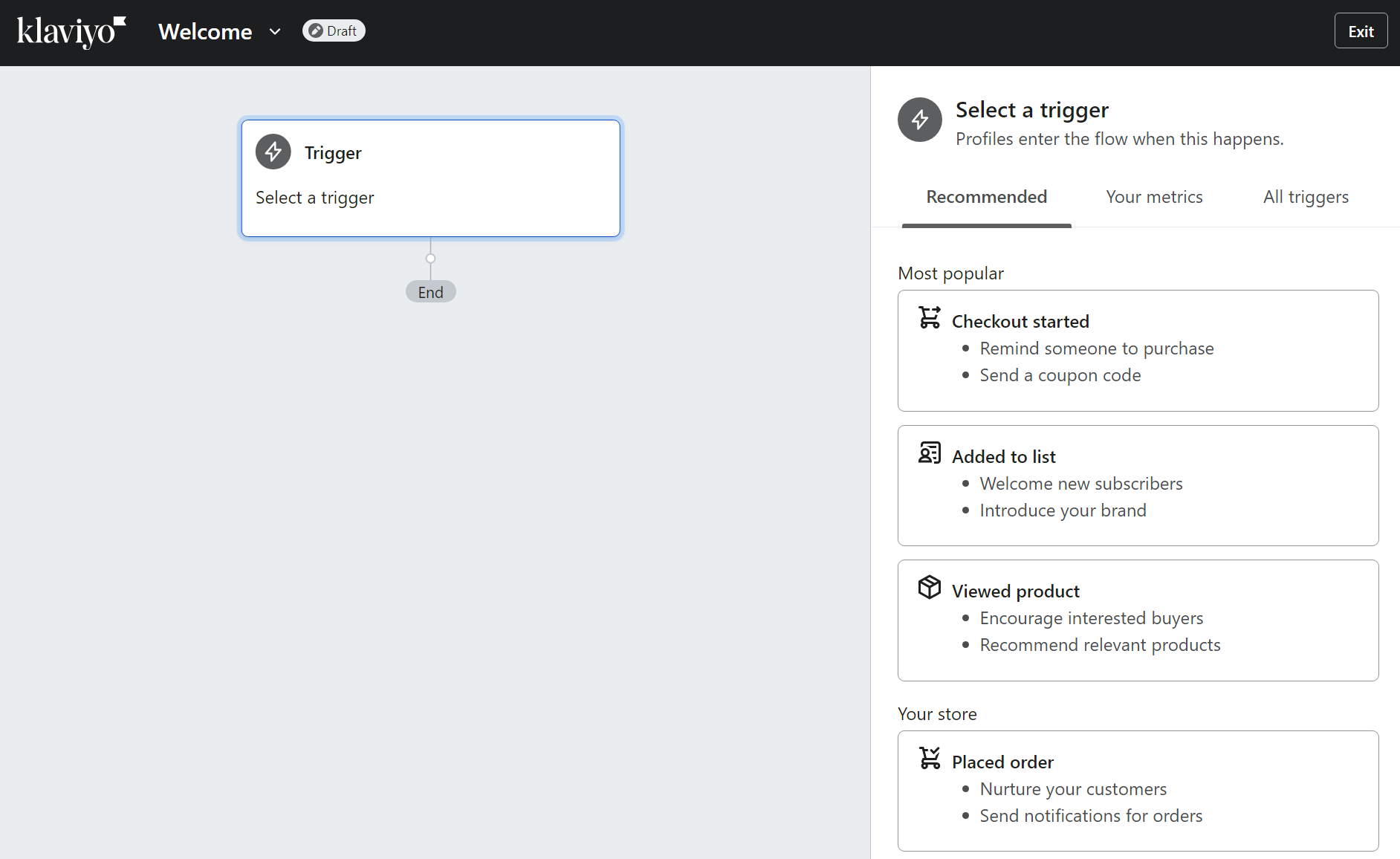
After entering your trigger, you get access to the builder, where you can add actions (such as email or SMS), webhooks, and time delays.
Creating a template from scratch in Omnisend is even simpler because it loads you straight into the automation builder with the trigger settings on show:

Winner
Klaviyo. It offers more pre-built flows covering unique ecommerce scenarios. However, that doesn’t mean you will need all of them.
 |
Kate Backdrop’s success story:
Kate Backdrop, a global leader in photography backdrops, achieved a remarkable 1:300 ROI using Omnisend’s omnichannel marketing. Initially relying on Mailchimp and Klaviyo, the brand faced challenges with limited automation and high costs before switching to Omnisend.The transition enabled it to increase engagement through email, SMS, and push notifications, resulting in significantly improved customer interactions. Its post-purchase automation achieved an 87% open rate, while push notifications had a 62% view rate. |
Customization and advanced triggers
Omnisend’s automation builder lets you stack conditions on top of each other. You can trigger flows based on customer segments entering or leaving, custom events from third-party apps like AfterShip or Gorgias, and standard ecommerce actions:

Each workflow accepts up to five trigger filters and four exit conditions. Split your flows based on order value, customer location, or past purchase behavior.
Add up to 10 conditional splits per workflow. A/B testing also works within automations, allowing you to test delays, channels, and content variations within the same flow.
Klaviyo’s flow builder uses six trigger types (list, segment, metric, date property, price drop, and low inventory). The last two are specialized triggers for alerting customers when products they’ve viewed drop in price or run low on stock.
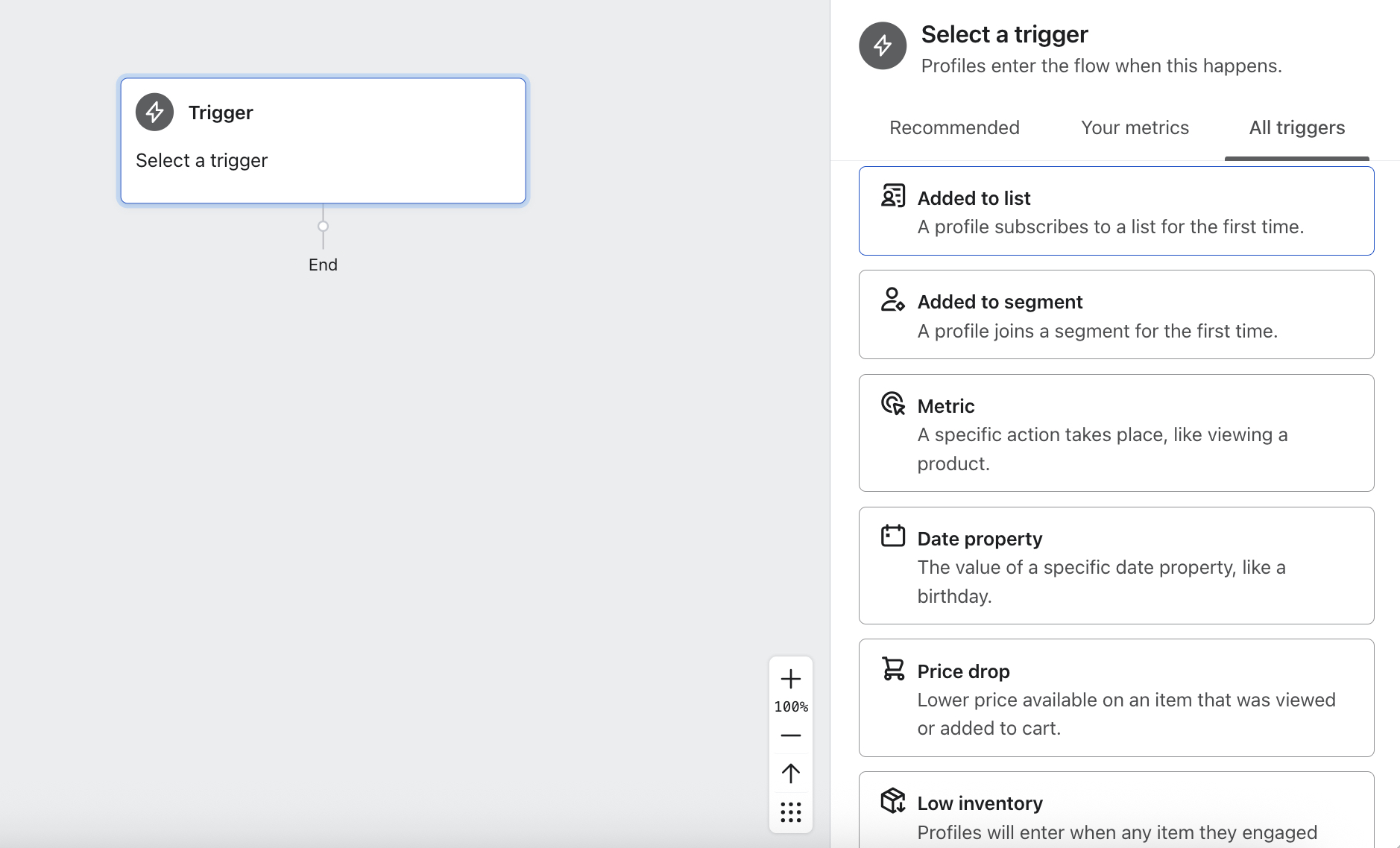
The key difference lies in how filters operate. Klaviyo uses two filter types:
- Trigger filters that evaluate the incoming event data (only available for metric and price drop flows)
- Profile filters that check customer attributes
Klaviyo checks profile filters before sending every message. So if someone places an order mid-flow, Klaviyo skips them from the remaining abandoned cart messages.
When someone fails a profile filter, Klaviyo keeps them in the flow but skips them from each action until they either qualify again or exit.
Winner
Draw. Omnisend allows 10 conditional splits per flow and integrates custom events from third-party apps. Klaviyo’s profile filters re-evaluate before each message, plus it offers price drop and low inventory triggers.
Multichannel automation
Klaviyo lets you combine email, SMS, and WhatsApp in flows, while Omnisend combines email, SMS, and web push notifications.
Omnisend has pre-built flows for email + SMS, and its flow builder provides a crystal-clear view of all elements you can edit:
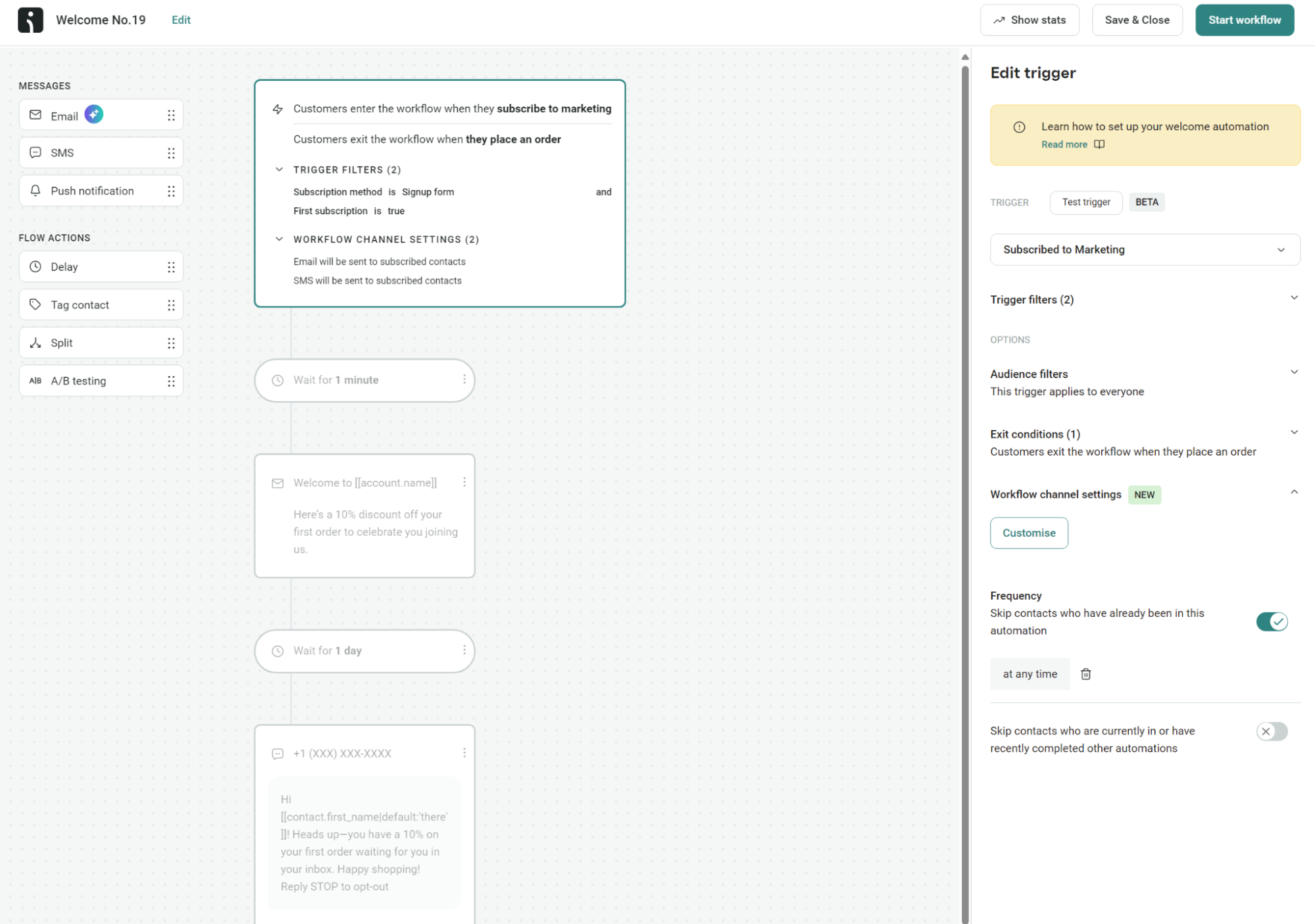
Because email, SMS, and push notifications are built into automations with their own triggers and delays, you can take an omnichannel approach, where each channel kicks in when you want it to, to reach customers.
Klaviyo also lets you add SMS messages alongside emails in the same workflow:
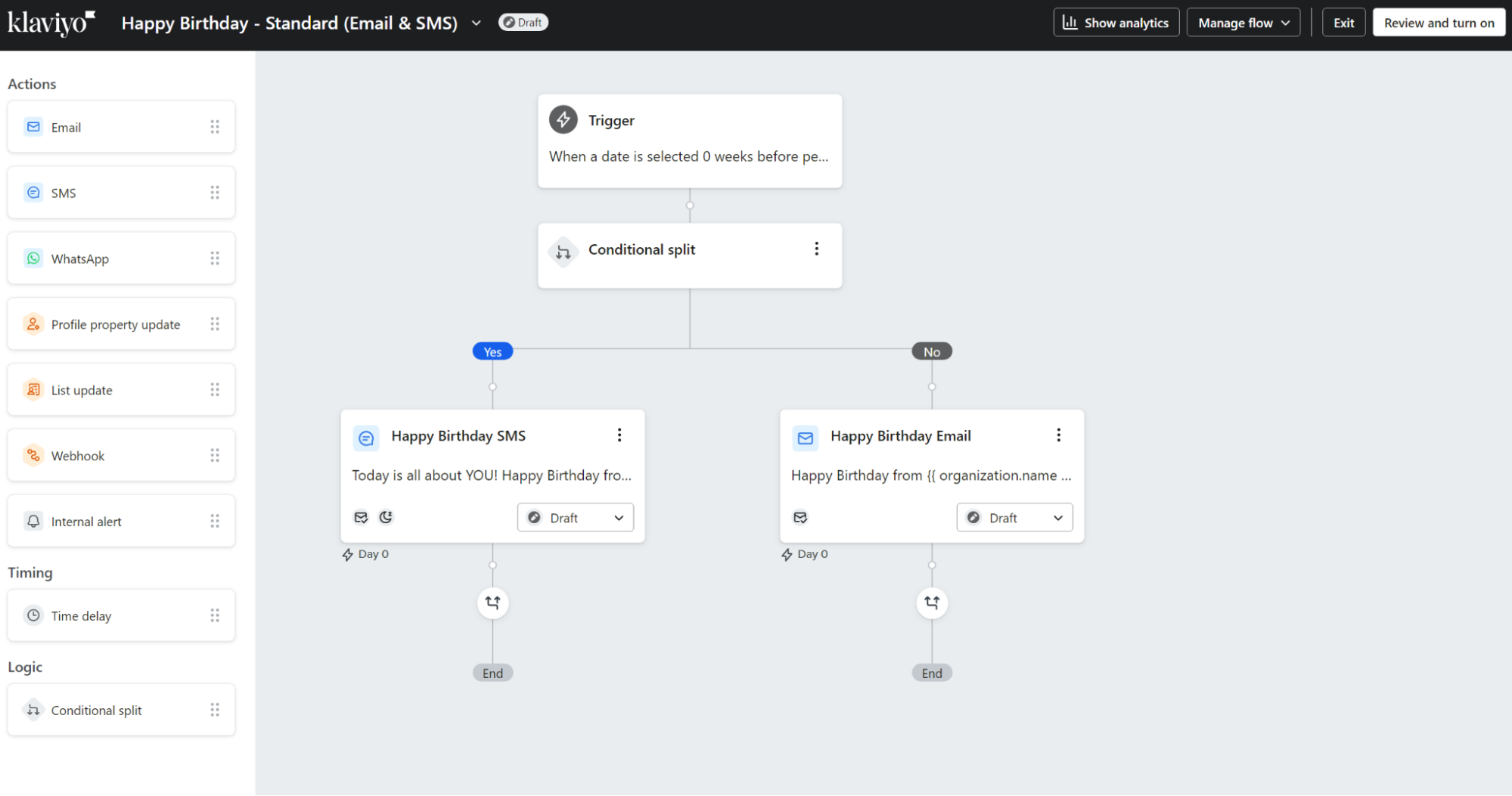
As with Omnisend, each SMS action includes compliance settings that vary by region. For instance, organizational prefixes for US and Canadian recipients, as well as non-US and non-Canadian recipients.
Klaviyo’s Smart Sending feature prevents customers from being overwhelmed with too many texts within 24 hours. MMS messages with images count as three sends for billing purposes. The same applies to Omnisend.
In terms of its multichannel capabilities, Klaviyo allows you to use email, SMS, and WhatsApp in your flows. Omnisend doesn’t support WhatsApp natively, but it does support web push notifications in flows, which Klaviyo doesn’t.
Winner
Omnisend, and it’s an easy win because it provides multichannel automations across all plans, while Klaviyo restricts them to its most expensive plans. Additionally, Omnisend lets you add a web push notification to your flow.
Klaviyo vs. Omnisend: Which offers better SMS marketing?
Did you know that US brands generated over $25 million in SMS sales in 2024? If you want a slice of it, your marketing tool needs to support SMS campaigns (one-time and scheduled sends) and automations, which accounted for 18% of orders from 9% of sends.
Both Omisend and Klaviyo enable you to send bulk SMS campaigns and add text messages to flows, ensuring TCPA compliance. You can target segments, schedule sends, and track performance.
The big difference? Omnisend can send SMS to over 200 countries worldwide. Klaviyo only works in 18 countries where they’ve set up proper sending infrastructure.
SMS pricing breakdown
The first thing to note is that Klaviyo includes bonus SMS credits in all its email + mobile messages plans, regardless of contact list size. These credits grow the more messages you intend to send per month, starting at 1,250 credits per 250 messages.
Klaviyo’s price per send starts at $0.012 in the US, including carrier fees at $0.003/send. That means one credit is equal to $0.012. For MMS, you’ll use three credits.
Your credits are used in different quantities depending on your location:
- US: One credit
- Canada: Three credits
- UK: Five credits
- Germany: 12 credits
- Australia: Four credits
Omnisend also offers bonus SMS credits equal to the price of your monthly plan in its Pro tier (starting from $59/month), which is a similar offer to Klaviyo’s.
However, Omnisend is more transparent in its SMS pricing. It costs $0.015 per message to US numbers, with prices varying by country. Additional credits start at $10/month, and credits roll over for 60 days. Plus, you see costs before sending.
Navigate to Store settings > SMS pricing in Omnisend to see the current rates, as below:

The table below provides a comparison between Klaviyo and Omnisend’s prices:
| Message type | Omnisend | Klaviyo |
|---|---|---|
| SMS (US) | $0.015 | $0.012 |
| MMS (US) | $0.045 | $0.036 |
| Difference | +25% more for SMS, +25% more for MMS | Cheaper |
Klaviyo costs less per message to US numbers. For 10,000 SMS messages, you’d pay $150 with Omnisend versus $120 with Klaviyo — a $30 difference.
Winner
Klaviyo, because it’s cheaper to send to US customers. However, Omnisend provides transparent SMS pricing breakdowns that you’ll find helpful for international audiences.
SMS features and capabilities
Omnisend utilizes toll-free numbers for SMS marketing and automatically formats phone numbers with country codes based on checkout data.
You can brand your SMS links using your own domain (though Omnisend suggests a subdomain separate from your email domain). MMS with images works for recipients in the US and Canada.
Omnisend’s SMS campaign builder is a breeze to use, thanks to its real-time text message preview and media manager for MMS:

Now, let’s take a look at Klaviyo’s SMS campaign builder:
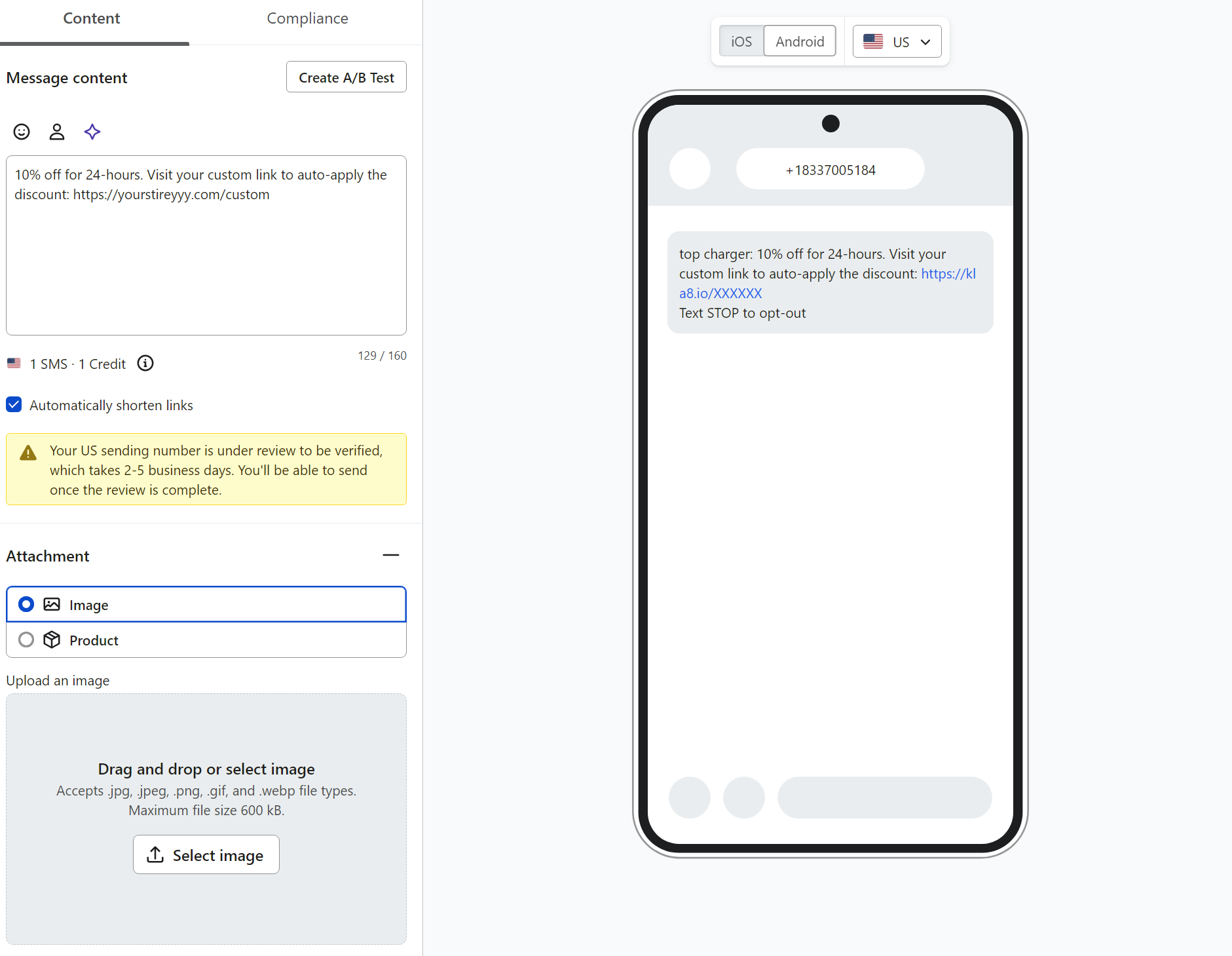
As you can see, it’s visually similar to Omnisend’s builder, so there’s no functionality lost in adding content and previewing your message.
Klaviyo’s infrastructure varies by region. In North America, one toll-free number serves both the US and Canada. For Europe and Australia, you get branded sender IDs — alphanumeric names instead of phone numbers that appear as the sender.
The catch is that branded sender IDs can’t receive replies, so two-way messaging only works where Klaviyo uses phone numbers (more on two-way messaging below). Want short codes or vanity numbers? Those cost extra on paid plans.
Winner
Omnisend, for global reach. While Klaviyo has a more sophisticated sending infrastructure in select markets, Omnisend can deliver SMS to 200+ countries versus Klaviyo’s 18. Unless you only sell to US/UK/EU markets, Omnisend’s broader coverage matters.
Two-way messaging capabilities
Klaviyo’s two-way messaging lets recipients text back to your business number, enabling SMS conversations, opt-in and opt-out keywords, and conversational flows.
It works with toll-free numbers, long codes, and short codes, but not with branded sender IDs since branded sender IDs cannot receive incoming messages.
Two-way messaging is available in the US and Canada and in countries with long codes or short codes. Klaviyo processes standard keywords like STOP, HELP, and START automatically without charging credits for these responses.
Omnisend does not natively support two-way messaging, but you can integrate Gorgias to communicate with US customers only.
When customers reply to SMS campaigns (except STOP/HELP keywords), Omnisend creates tickets in Gorgias. Your support agents can respond once per ticket through Gorgias, and replies route back through Omnisend to customers.
Winner
Klaviyo wins with native two-way messaging across multiple countries. Omnisend requires Gorgias integration, works only for US customers, and limits one reply per ticket.
SMS automation options
Omnisend treats SMS in automations like any other channel. You can add SMS blocks anywhere in your workflow, mix them with email messages, and automatically pass non-opted contacts to the next channel.
It formats phone numbers with country codes based on checkout data and sends them using toll-free numbers. If someone lacks SMS consent or you run out of credits, Omnisend sends them an email instead of failing the whole automation.
For instance, Omnisend offers separate presets for abandoned carts (products added but not checked out) and abandoned checkouts (checkout started but not completed). Each workflow has different triggers and exit conditions:

Klaviyo requires conditional splits to add SMS to abandoned cart flows, where you manually build logic to check SMS consent and route recipients accordingly. Those conditional splits add additional work that Omnisend doesn’t need:
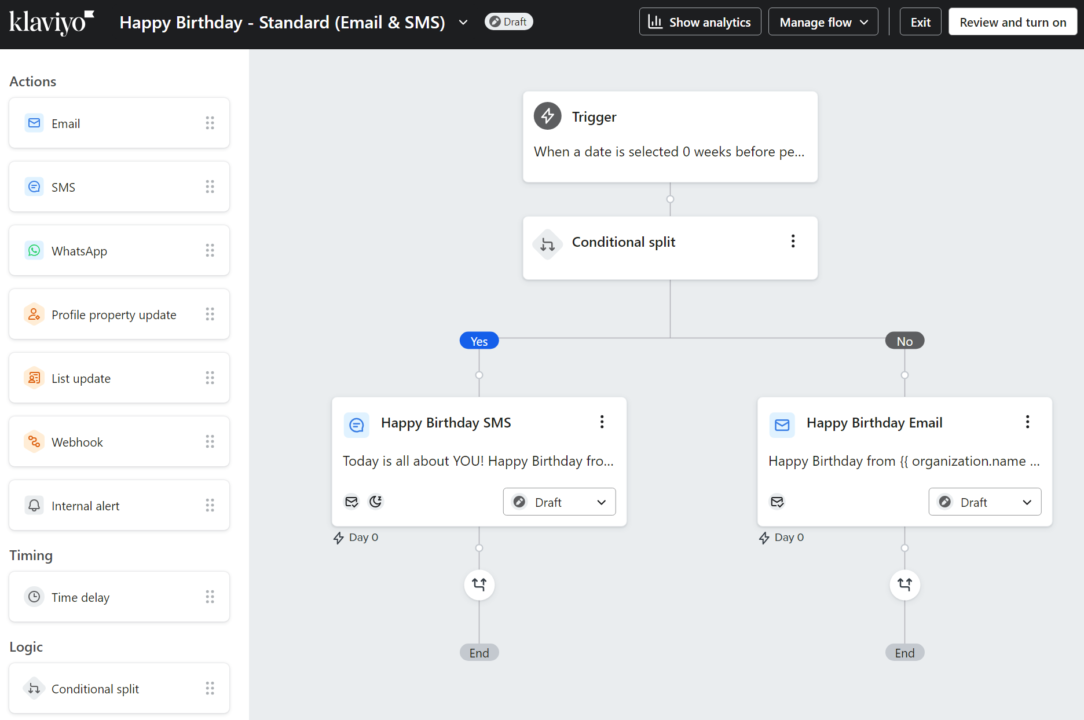
However, Klaviyo has a unique feature — it supports conversational SMS automations, allowing customers to text keywords and participate in interactive surveys, quizzes, or buying guides. It recognizes numbered choices and typos using fuzzy matching.
Each automation runs as a timed session, accompanied by additional prompt messages for unrecognized responses. You can set them to trigger only after someone receives a certain flow message, or leave them open so anyone can start them by texting the keyword anytime.
Winner
Draw. Omnisend wins for simplicity with email + SMS flows and no manual splits. Klaviyo wins for innovation with conversational SMS flows that work like chatbots. Choose based on whether you value ease of setup or advanced interactive features.
Which platform offers better customer segmentation?
Your leads aren’t just faceless emails — they’re real people who want to feel valued by the brand they trust. So, sending the same message with a robotic tone just won’t cut it.
Dividing your audience into smaller, more specific groups will help you create messages that actually speak to them, leading to better engagement and conversions.
Omnisend and Klaviyo take different approaches when it comes to segmentation and targeting.
| Feature | Omnisend | Klaviyo |
|---|---|---|
| Segmentation flexibility | Allows segmentation based on purchase history and customer behavior | Highly flexible segments with advanced customization options |
| Ease of segmentation | Quick setup of basic segments | Slightly more complex |
| Real-time updates | Basic real-time updates, allowing for timely responses based on certain activities | Pinpointed real-time tracking with quick data synchronization |
| Behavioral targeting | Targets based on email clicks, purchases, and site visits | Advanced behavioral targeting, including browsing behavior, purchase history, and more |
| Custom rules | Based on basic activity and campaign history | Highly customizable rules based on various user behaviors and data points |
Winner
Both platforms are closely matched. However, Omnisend has the edge.
Omnisend gives you a flexible segment builder that lets you tap into 500+ data points — whether based on purchase history, product views, or specific campaign activity. Omnisend allows you to create particular segments that align with your goals.
This is a must-have tool for actions like targeting customers who abandoned their cart or those who haven’t bought in a while.
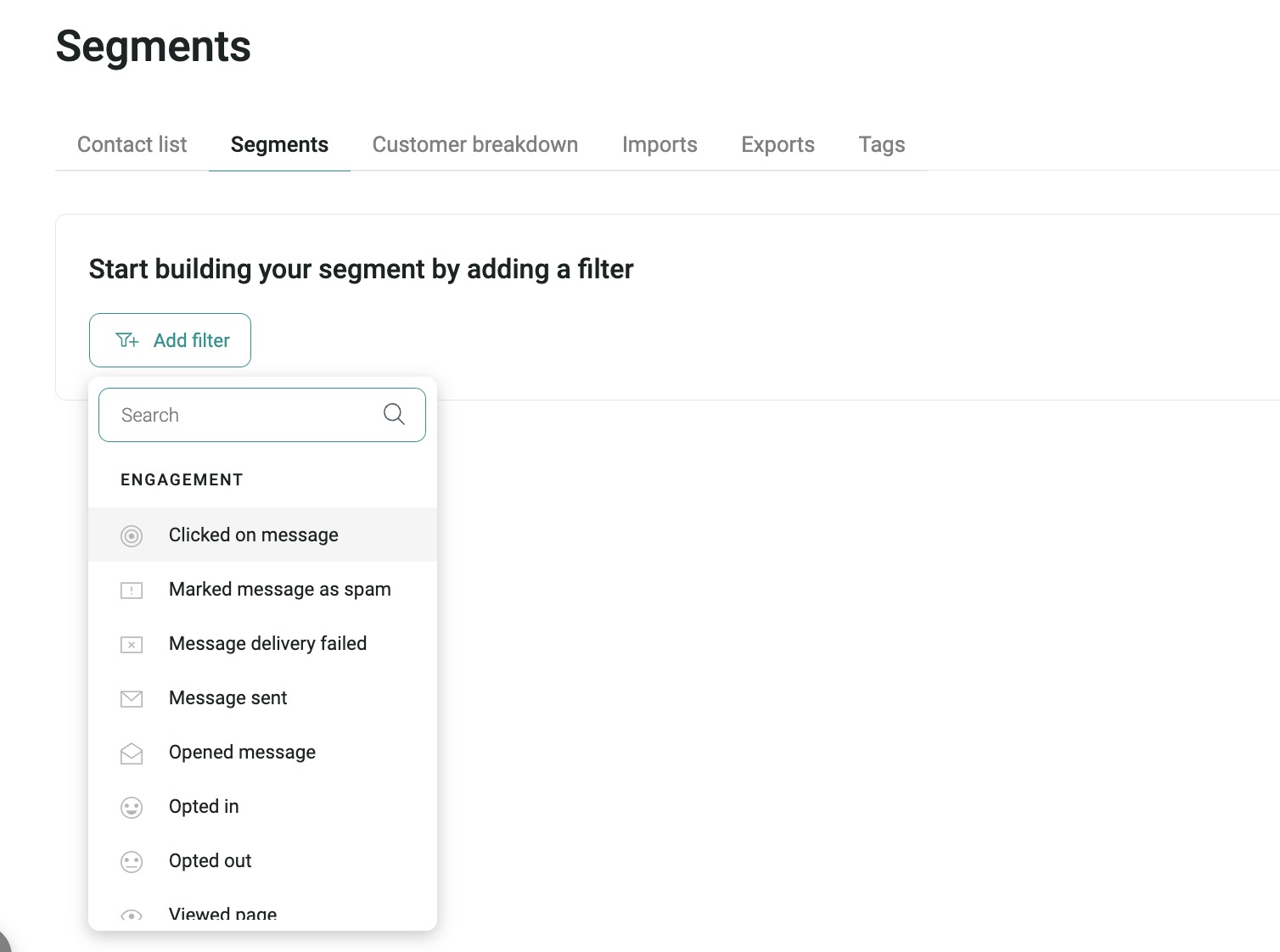
Klaviyo’s segmentation is more basic. It supports conditional rules that can be built around various customer behaviors and engagement metrics.
You’re asked to define “what someone has or has not done,” which could be campaign-related, shopping-related, or something else.
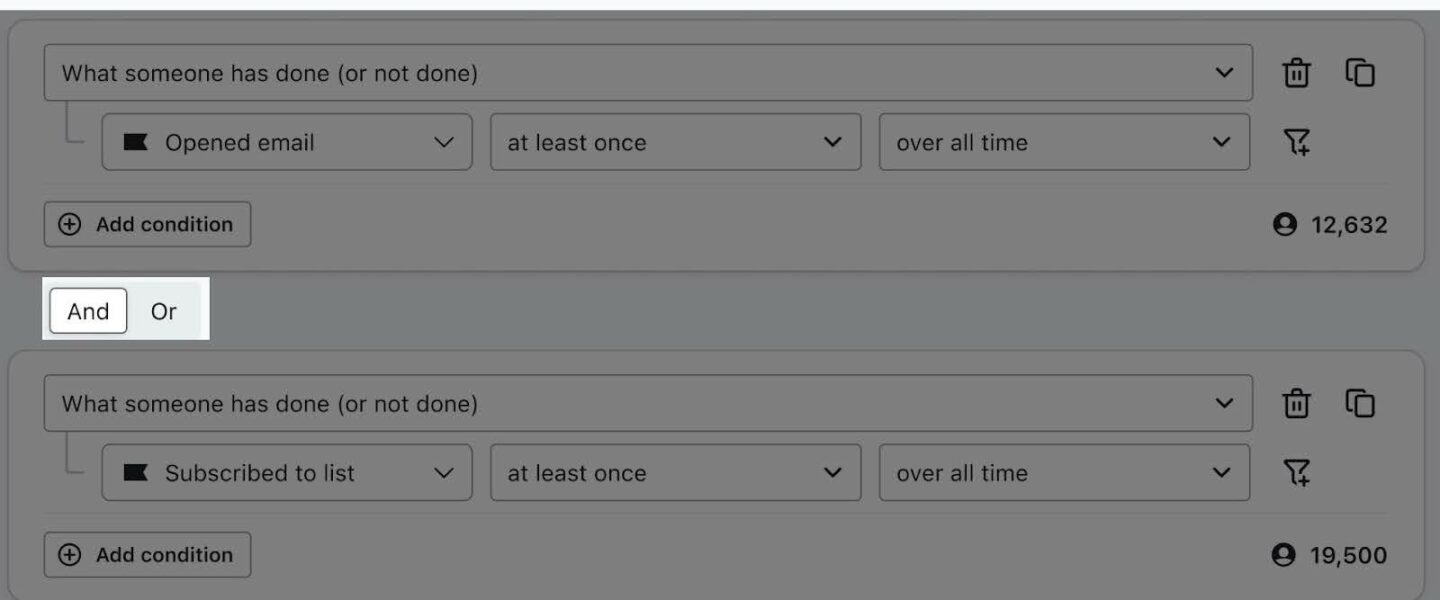
When it comes to ease of use, Omnisend takes the win, especially for those who prefer a hassle-free setup. For newer users or smaller teams, this is a huge time-saver. No need to dive into complex data points or spend days setting everything up.
Even though Klaviyo’s segmentation is intuitive, it requires a bit more familiarity with customer data. It’s great only if you want to get granular with customization.
Which platform has better email deliverability?
Poor deliverability means your emails never reach the intended audience, wasting every hour spent on design. Your email platform controls authentication protocols, sender reputation monitoring, and compliance enforcement — factors that determine whether ISPs route you to the inbox or spam folder.
The good news is that Omnisend and Klaviyo handle deliverability elements automatically, and once you have everything configured, you should see high delivery rates.
Authentication and technical setup
You need a custom domain email address for sending campaigns with Omnisend. Gmail, Yahoo, and other free email providers won’t work.
Domain signature (SPF/DKIM) setup is technically optional but strongly recommended for deliverability. At least one authentication method (SPF, DKIM, or DMARC) must pass validation to verify your domain.
Authentication runs on shared IPs by default, with dedicated IPs available for high-volume senders, and you must complete a warmup process.
Stricter authentication requirements apply in Klaviyo, especially for bulk senders and those with large campaign requirements. You must set up a branded sending domain to remove the “via klaviyomail.com” disclaimer and improve deliverability.
Gmail and Yahoo compliance require setting up a DMARC policy on your root domain. Your from-address domain must align with your branded sending domain for DMARC compliance.
Winner
Draw. Both platforms have the necessary authentication requirements for deliverability.
Deliverability tools and monitoring
Omnisend’s deliverability reports track sender health, domain performance, and email list hygiene in one interface:
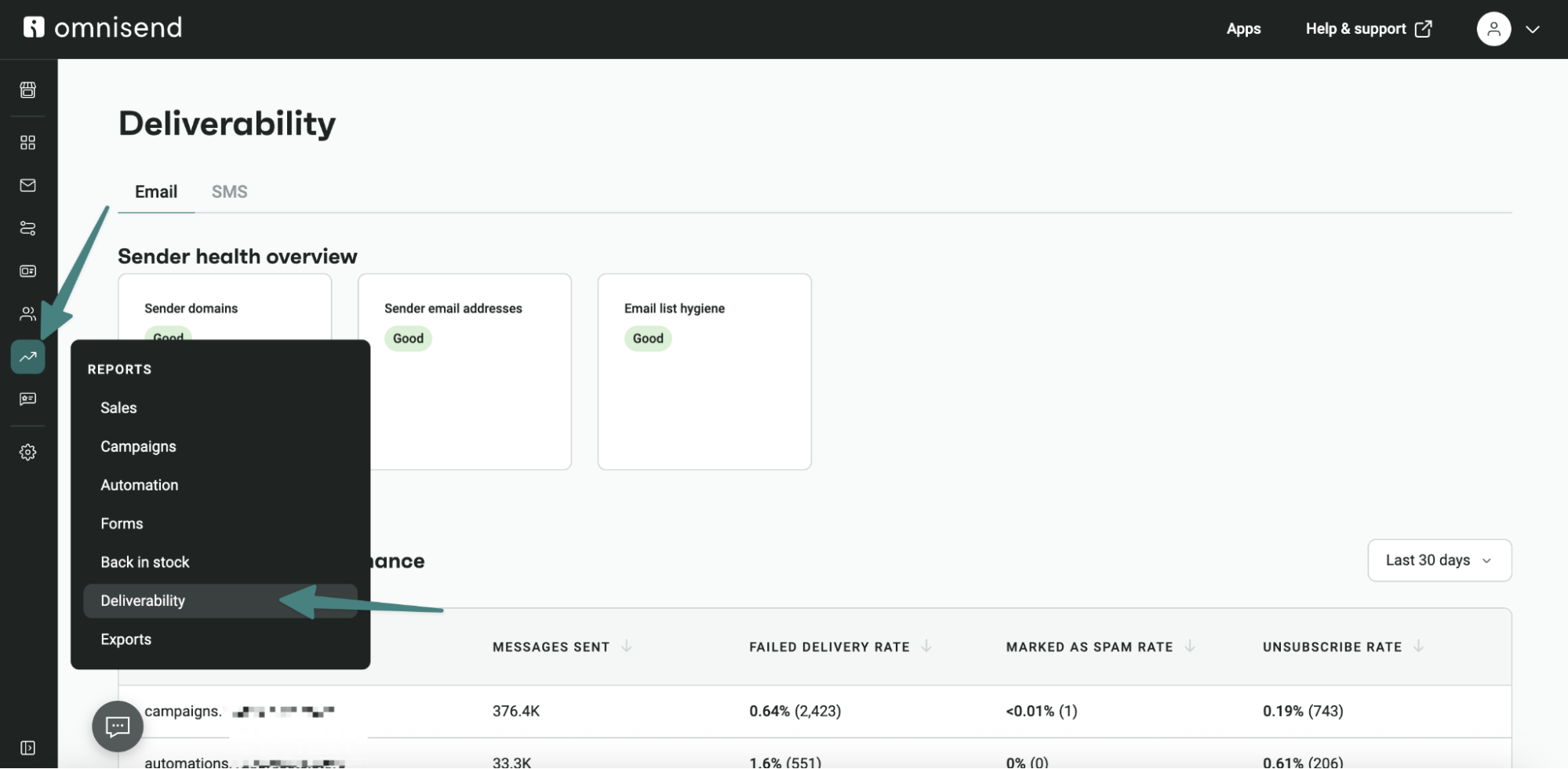
Reports show failed delivery rates, spam rates, and unsubscribe rates by domain. It monitors sender email addresses and flags issues with personal email usage. You get performance breakdowns for your top 100 email domains.
Klaviyo’s Deliverability Hub offers similar centralized monitoring, along with an action center for recommendations. Reports break down performance by inbox providers (Gmail, Yahoo, Outlook) to identify problem areas:

Google Postmaster Tools integration provides deeper Gmail insights, and real-time tracking of engagement metrics shows their direct impact on sender reputation scores.
Winner
Klaviyo. Its deliverability hub provides more information, although you might not need all of it, since Omnisend tracks all crucial metrics.
Support for maintaining sender reputation
Omnisend recommends sending to engaged segments using timeframe-based criteria (7, 14, or 30 days since the last action). The 80/20 rule focuses on revenue-generating subscribers, which can improve your engagement metrics.
Reputation management features include:
- List cleaning at $0.20 per 100 contacts for poor-quality addresses
- Warmup plans for new accounts and domain switches
- SPF/DKIM/DMARC record setup assistance
- Domain blacklist checking and monitoring
- Segmentation strategies based on opens, clicks, and purchases
- Content guidelines to avoid spam triggers
- Dedicated IP options for high-volume senders
Klaviyo automates reputation management with built-in features:
- Sunset flows that phase out unengaged subscribers automatically
- Deliverability Hub with overall health scores and action recommendations
- Branded sending domain setup (required for bulk senders)
- DMARC policy enforcement and alignment checking
- Gmail and Yahoo 2024 requirements implementation
- One-click unsubscribe headers in all emails
- Google Postmaster Tools integration for Gmail-specific insights
- Performance breakdowns by inbox provider (Gmail, Yahoo, Outlook)
Winner
Draw. Both platforms offer comprehensive deliverability hubs with domain monitoring and list hygiene tools. Klaviyo edges ahead with automated reputation management, while Omnisend provides comparable tracking at a lower cost.
How does AI compare in Klaviyo vs. Omnisend?
Klaviyo’s AI features include Smart Send Time optimization, Reputation Repair AI for enhanced deliverability, automated subject line generation, copywriting, predictive analytics for customer lifetime value and churn prediction, and performance benchmarking with actionable recommendations.
Omnisend’s AI features include an AI segment builder, subject line and preheader generators, AI Writer for enhancing existing content, and Direct Copywriting for generating new email text.
Additional AI features include the Dynamic Product Recommender for personalized products, Campaign Booster for automatic resends, Brand Assets AI for consistent styling, and Customer Breakdown using RFM analysis.
All AI features are included free of charge in Omnisend, whereas Klaviyo only includes them in its paid plans.
AI-powered content creation
AI generates subject lines, email body content, and product descriptions in Omnisend. Brand Assets AI automatically applies your logo, fonts, and colors to templates.
Your brand voice remains consistent with AI Writer’s review of grammar and tone. Direct Copywriting learns from your past campaigns to match your style, and Campaign Booster takes another shot at non-openers 48 hours later with fresh subject lines.
Here’s the AI content feature in action in the email editor:
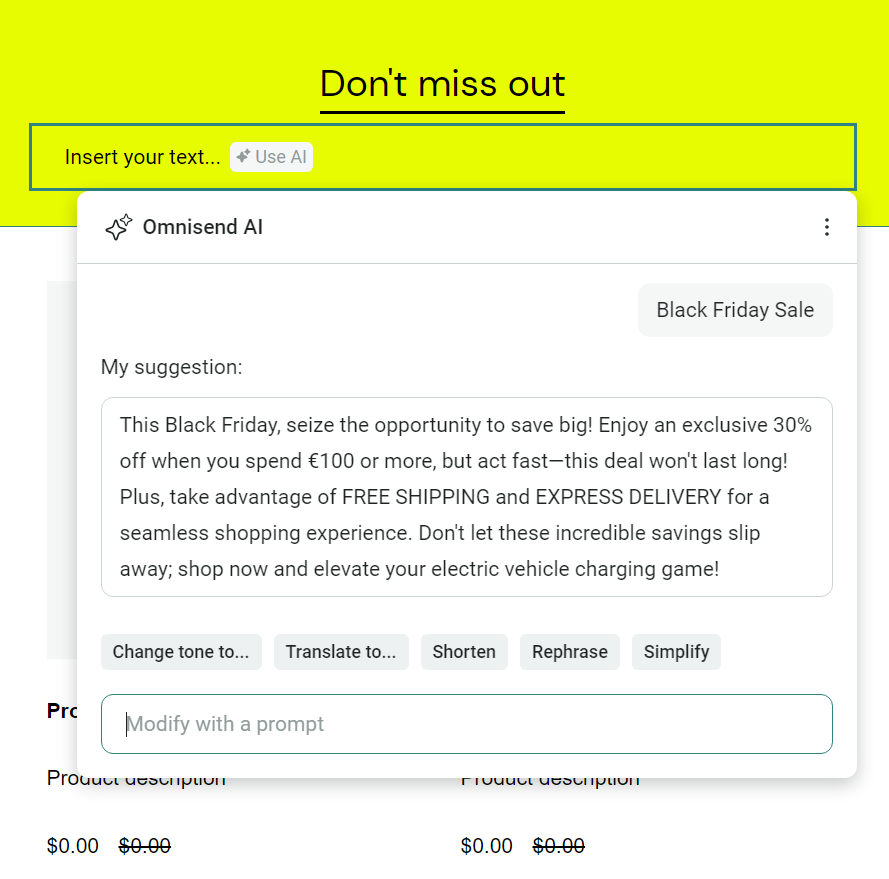
And now, here’s Omnisend’s AI subject line generator in action:

Overall, AI feels like a natural part of your workflow in Omnisend.
Klaviyo has similar AI content creation features, generating subject lines and email copy from natural language prompts. It adapts to your brand voice based on examples you provide:
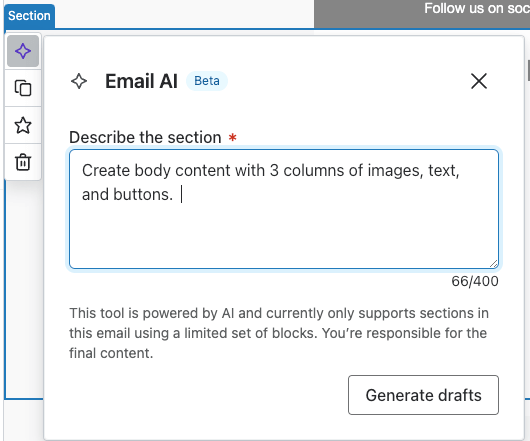
The quality of Klaviyo’s outputs is on par with Omnisend’s, although the interface is more outdated. A prime example is the subject line generator, which doesn’t have a conversational element, making the process less collaborative:

Winner
Omnisend. Its generative AI features are more helpful and can really assist you in improving the quality of your content.
Predictive analytics and insights
Customer Breakdown in Omnisend uses RFM analysis to sort your list into VIPs, at-risk customers, and re-engagement targets. Churn Prediction identifies individuals who are about to unsubscribe.
You get retention tactics tailored to each customer segment, and your campaign metrics show performance but don’t predict individual behavior patterns.
Individual-level forecasting sets Klaviyo apart with lifetime value and churn predictions for each subscriber, enabling more informed decisions. A/B tests declare winners automatically mid-campaign, and your metrics appear alongside industry benchmarks with improvement suggestions.
Winner
Klaviyo for its predictive CLV and churn predictions, which will help you identify customers most likely to buy and those who are at risk.
Personalization capabilities
Omnisend’s Dynamic Product Recommender shows items based on what customers recently browsed or purchased:
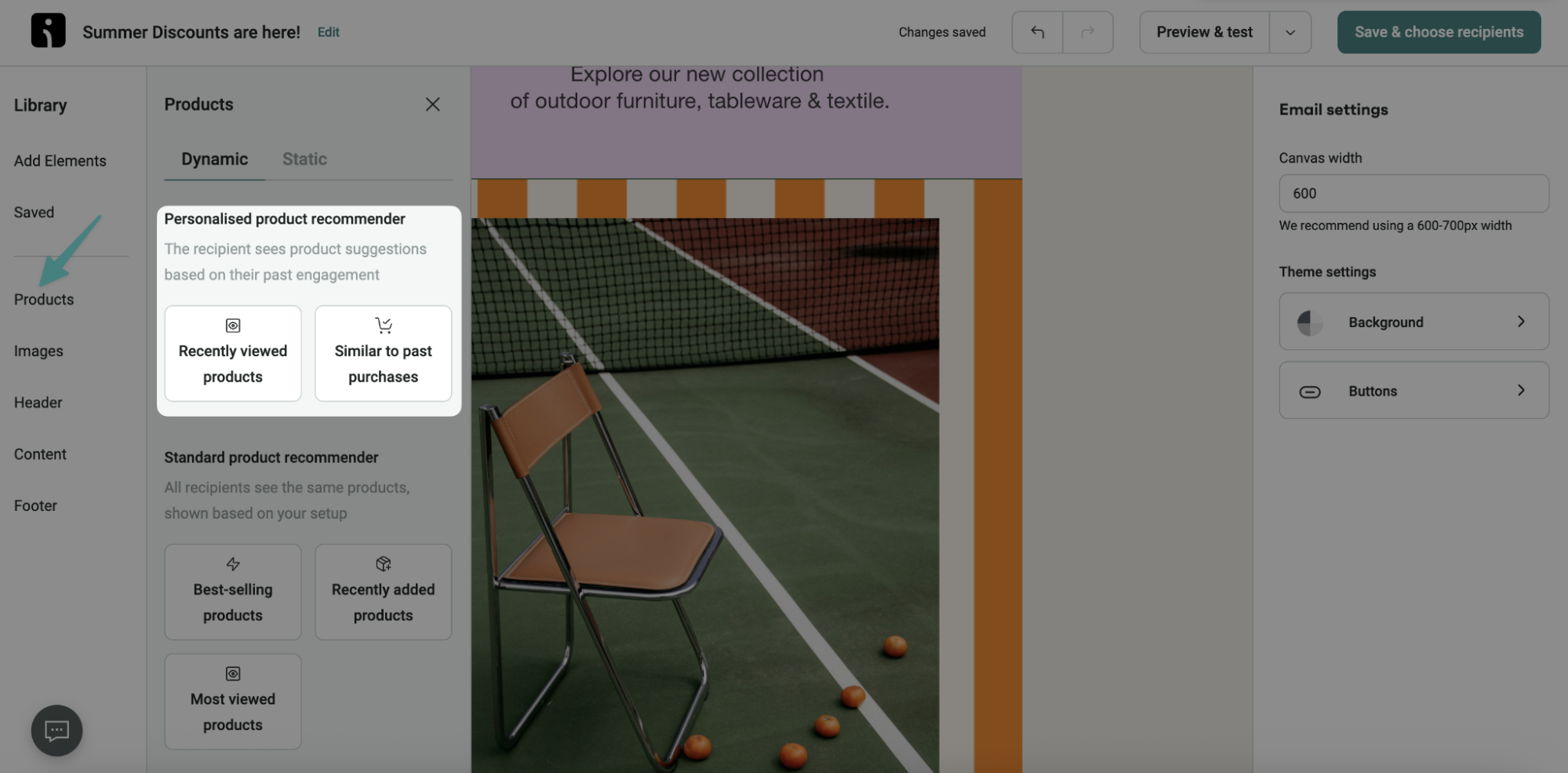
Separately, the AI Segment Builder lets you type descriptions like “big spenders who haven’t bought lately” and instantly creates the audience. If your request needs clarification, a chat interface asks follow-up questions to help refine the segment:

Klaviyo’s AI builds detailed customer profiles from every interaction — browsing patterns, cart activity, purchase history, and engagement data.
Product recommendations adapt in real time as customers browse your site, with predictive analytics identifying high-value customers before they reach spending milestones.
Segments AI creates audience groups for you, while RFM groupings and CLV predictions power advanced targeting. All customer data flows between email and SMS channels (if you have the email + mobile messages plan) for consistent personalization.
Winner
Draw. Both tools have AI segment builders and dynamic product recommenders. Although Klaviyo’s AI segment builder is more sophisticated with predictive data, it isn’t as intuitive. Unless you have a large dataset for it to utilize, the predictive element isn’t particularly beneficial.
Which platform has better analytics?
There’s no point in creating campaigns and flows if you don’t track them. How else would you know if they’re generating sales, or even being read? Klaviyo and Omnisend both provide high-level performance metrics, including sales and revenue tracking.
Reporting dashboard compared
The home dashboard in Omnisend offers snapshot reports on sales performance and audience growth, along with buttons to access additional reports. Alternatively, navigate to Reports in the sidebar and select from the following:
- Sales
- Campaigns
- Automations
- Forms
- Deliverability
Standard email metrics include open rates, click-through rates, order placement rates, revenue per message sent, failed delivery rates, spam rates, and unsubscribe rates.
Campaign reports show messages sent, engagement metrics, and conversion data across email, SMS, and push channels:
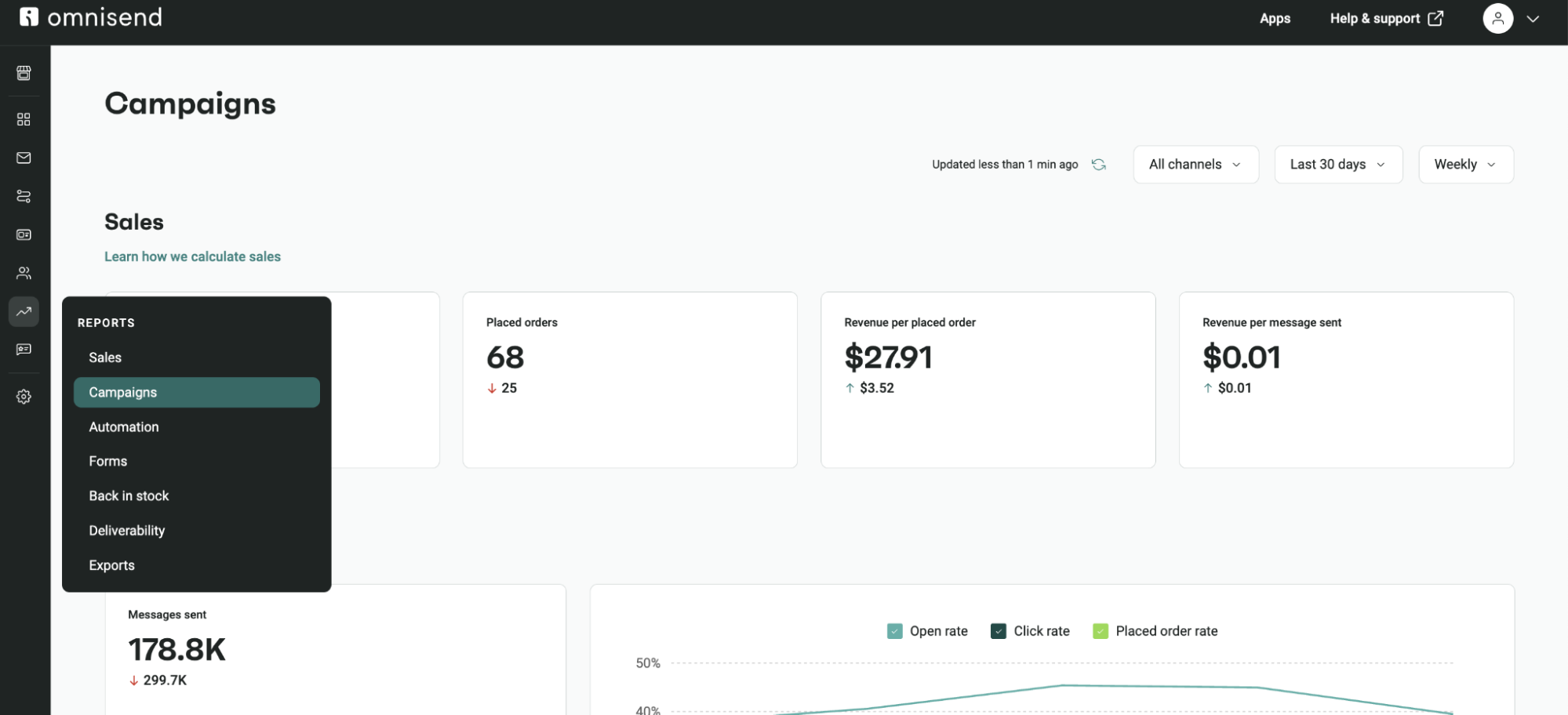
The Automation report shows the same metrics:
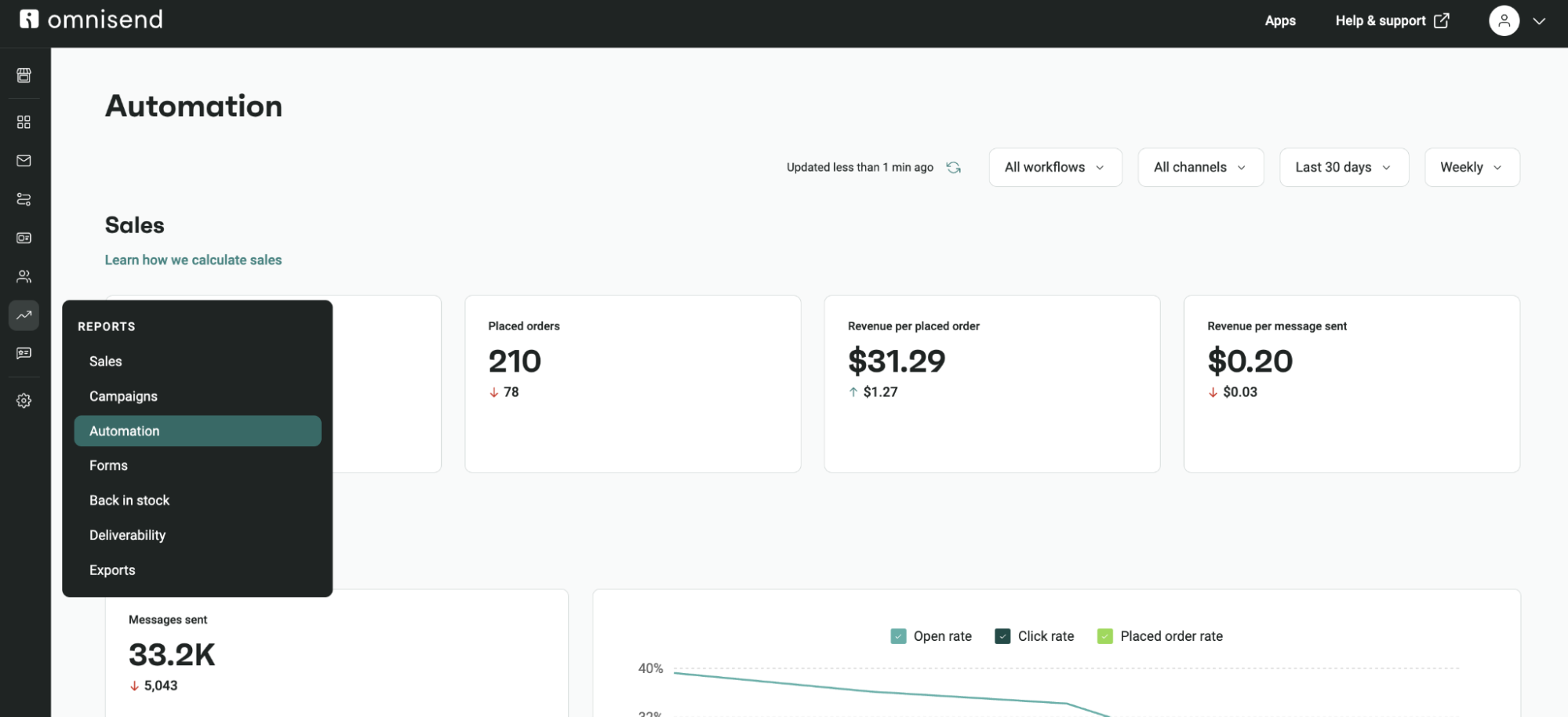
The Sales tab in Omnisend breaks down your total store revenue, showing what your email and SMS campaigns generate versus everything else. You can see revenue trends, compare marketing-attributed sales to other channels, and track average order values:
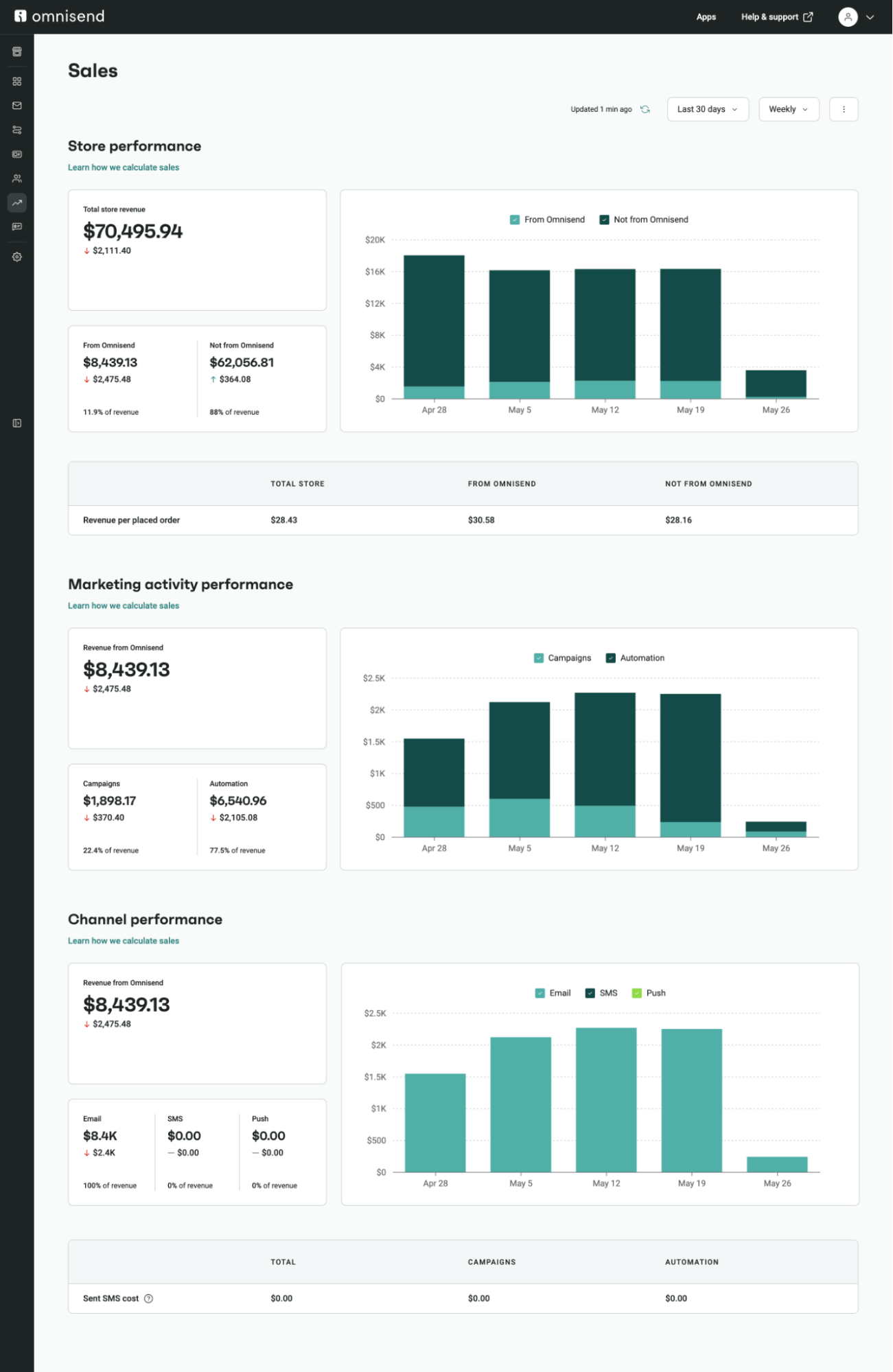
Omnisend displays metrics directly on dashboard screens, while Klaviyo often requires clicking into individual reports for detailed data.
However, Klaviyo’s reports are more data-rich. Its Dashboards tab under Analytics provides the following snapshots:
- Growth overview
- Campaign performance summary
- Flow performance summary
- Deliverability
- Industry benchmarks
- Segment growth summary
The image below shows the Dashboard tab in action:
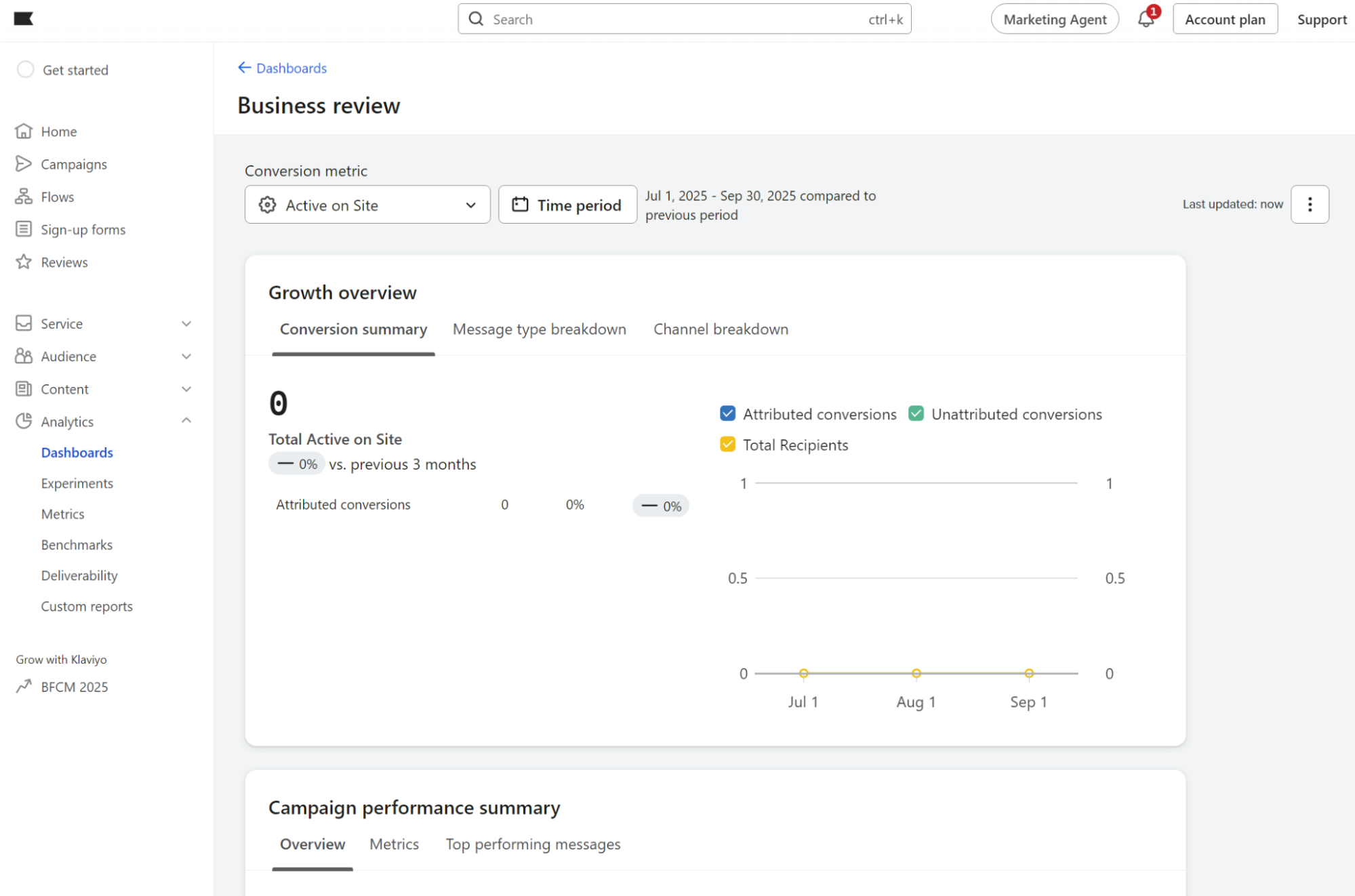
Like Omnisend, Klaviyo also provides some basic reports on its home screen, specifically a business performance summary and an overview of top-performing flows. Click one of those, and you can see additional metrics, like this:

Winner
Draw. Omnisend presents core metrics upfront in a clear and straightforward layout, making the data immediately accessible. Klaviyo offers a range of report types, including industry benchmarks and segment growth summaries.
Customization and advanced reporting
Pro plan users in Omnisend access channel trends, segment performance analysis, and custom date ranges. You filter by channels, date ranges, and time granularity.
The image below shows how easy it is to select a custom date range:
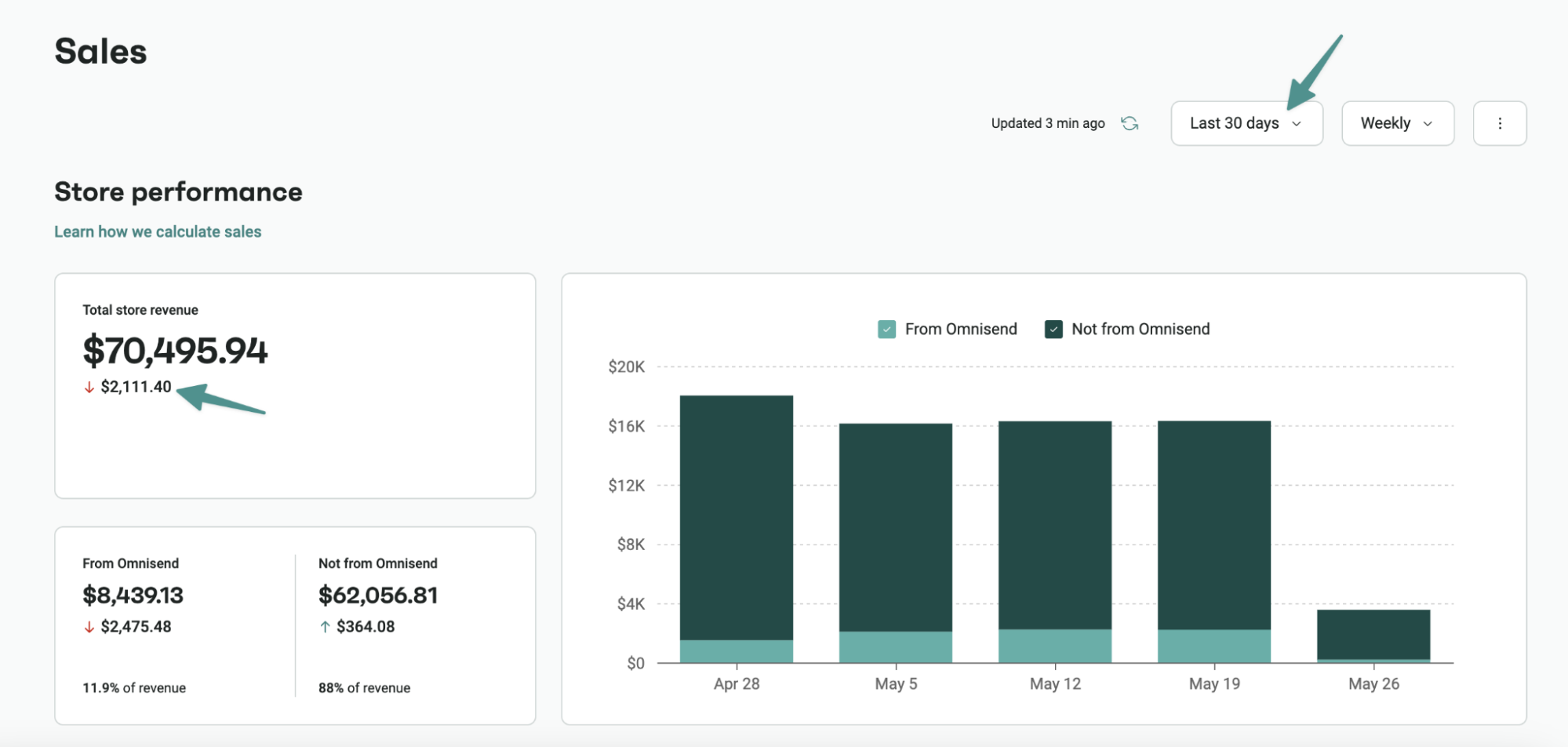
PDF exports let you share campaign and automation reports. Segment performance shows how different audience groups convert, tracking your targeted segments with breakdowns by revenue and engagement metrics.
Custom reports in Klaviyo are based on five pre-built templates, including single-metric deep dives, multi-metric analyses, and product performance reports. You select report types, apply filters, and group data by properties.
Campaign performance reports track engagement and conversion trends. Flow reports analyze automation metrics, and custom date ranges span up to two years with adjustable time intervals.
Winner
Draw. Omnisend provides segment performance tracking and PDF exports on Pro plans. Klaviyo offers more report types, but both platforms deliver the analytics your ecommerce store needs.
Revenue tracking and attribution
Total store revenue is reported in Omnisend, separating marketing-attributed sales from other sources. You can customize attribution windows by channel, with defaults of seven days for email and 24 hours for SMS.
Attribution begins when messages are sent or when contacts engage, and last-touch rules apply when customers interact with multiple messages before making a purchase.
Revenue attribution in Klaviyo encompasses campaigns and flows, featuring adjustable conversion metrics. Campaign conversion reports display products ordered by customers who have converted.
Attribution data includes campaign-level metrics and conversion tracking. You can export analytics data in CSV format for detailed analysis. Reports track performance across different time periods with customizable date ranges.
Winner
Klaviyo wins with real-time revenue updates and multiple attribution models. Omnisend covers the basics well, but Klaviyo provides deeper insights into customer purchase paths and product performance.
Which integrates better with your ecommerce stack?
Klaviyo integrates with 350+ apps, with its most impressive integrations comprising ecommerce platforms and CRMs. Omnisend integrates with over 160 apps, although the number may seem fewer on paper, as it covers most tech stacks with Zapier support for additional integrations.
Ecommerce platform integrations
Ecommerce integrations let you save time creating the link between your email tool and store. For instance, the Shopify app for Omnisend automatically starts syncing historical data, such as contacts, products, and orders.
Omnisend has native apps for the following ecommerce platforms:
- Shopify
- WooCommerce
- BigCommerce
- Wix
- Shoplazza
- Ecwid
- nopCommerce
- PrestaShop
- WordPress
- Big Cartel
- SureCart
- Shopify Plus
Here’s a screenshot of its App Market:
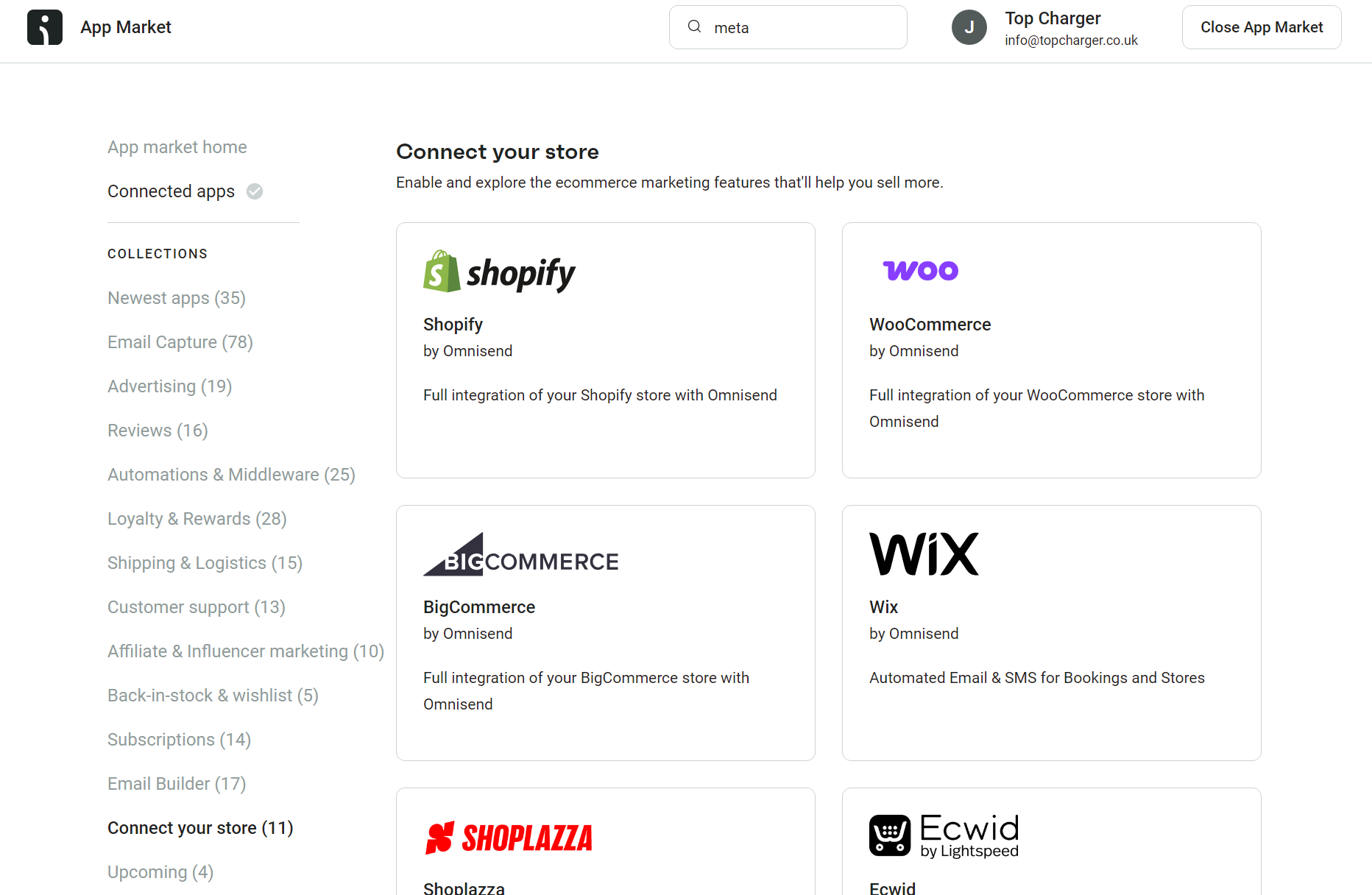
Klaviyo supports more platforms than Omnisend. The image below shows its App Marketplace:

These ecommerce apps are listed in its App Marketplace:
- 29 Next
- BigCommerce
- CommentSold
- Commerce7
- Fourthwall
- Magento 2
- OpenCart
- PrestaShop
- Salesforce Commerce Cloud
- Shift4Shop
- Shopify
- Spree
- Volusion
- Wix
- WooCommerce
Winner
Klaviyo, because it supports more platforms via native apps. However, if your platform is listed above, there’s no advantage.
Marketing tool ecosystem
Omnisend’s app market connects your email marketing with tools for advertising, reviews, loyalty programs, and influencer marketing.
You can sync Facebook Custom Audiences directly from your segments, push campaigns to social media, or connect affiliate tracking from Goaffpro.
The image below shows how to set up a segment for a Facebook Custom Audience:
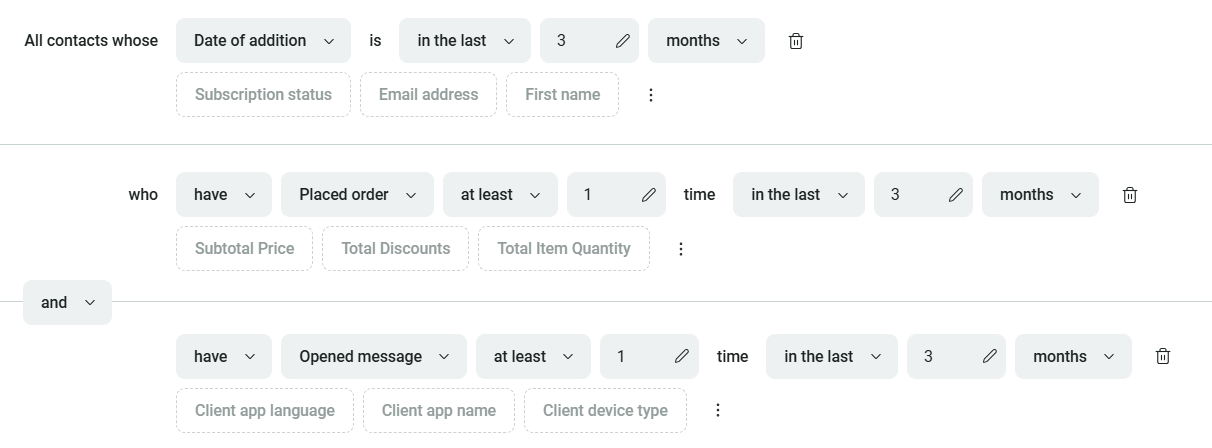
Popular integrations include Postscript for SMS collection, PageFly for landing pages, and GrowthHero for influencer campaigns. Quizell creates interactive quizzes that convert visitors into customers and feed data into your campaigns.
Klaviyo offers CRM functionality that Omnisend lacks, particularly with Salesforce integration that syncs leads hourly and enriches your profiles with sales pipeline data.
Your advertising reach extends to Pinterest, TikTok, and X audiences beyond the Google and Facebook connections both platforms share, with Pinpoint capturing leads from Instagram and TikTok DM conversations and feeding them into your Klaviyo lists.
Another worthwhile integration is Vibe, which lets you retarget email subscribers on connected TV platforms with real-time audience syncing.
Winner
Klaviyo, because it connects to more advertising platforms and Salesforce. Omnisend covers the email marketing basics. Pick Klaviyo if you need CRM data or TikTok ads.
API and custom integrations
Custom ecommerce platforms require API integration when pre-built apps aren’t available for Klaviyo or Omnisend.
You’ll write JavaScript to track browsing behavior and product views, then connect backend systems for order processing. Frontend code captures what customers look at. Backend code syncs purchases and profiles.
Without developer knowledge, you’re stuck, because both email tools require coding skills to build these connections. High-quality API documentation is available, but it assumes technical familiarity with webhooks and JSON payloads.
Winner
Draw. Omnisend and Klaviyo provide API integration for custom integrations and share similar difficulty levels.
Can you manage multiple stores in one account?
Running multiple ecommerce brands can be tedious if you have to toggle between the tabs whenever you want to check their status. To manage things without sweating it out, you’ll need an email marketing tool that lets you manage everything in one place.
With Klaviyo, you’ll have to create a separate account for each store. This means there’s always the hassle of setting up different campaigns, workflows, and marketing strategies. While it gives you complete control over each brand, managing multiple logins and accounts can be tiring.
When you log in with an email and password linked to multiple accounts, you’ll go straight to the account you used last. This means you’ll need to log in each time you want to access a store.
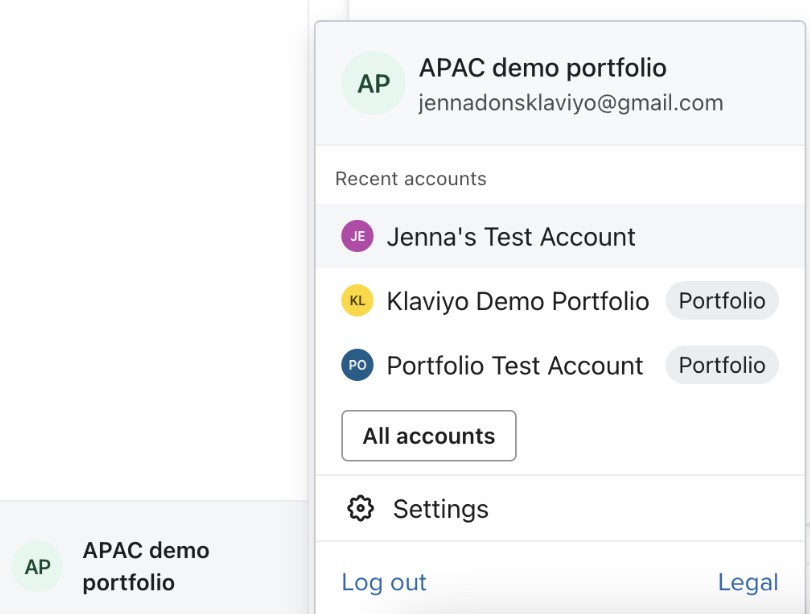
Omnisend, on the other hand, is much more intuitive. You can create a single multistore account to manage email communications for different brands or stores without the hassle of juggling logins or remembering passwords.
Switching between stores takes just one click — no friction, and no wasted time. You’ll find a list of all the stores linked to your account in the Stores tab.
Want to manage a specific one? Just hit the Access button next to it. It’s built to feel natural, so you can get more done without getting slowed down by the tech.

You can also quickly share marketing assets, such as email templates, SMS campaigns, and automated workflows, across all stores. This can save time and also help ensure your branding and messaging stay consistent.
Winner
Omnisend takes the lead, allowing you to manage multiple ecommerce stores from a single account.
Which offers better customer support?
There are two support types you can access with Klaviyo and Omnisend:
- Human support, where you chat to an expert
- Self-serve support, where you read and watch tutorials
The quality of both is extremely high, but Omnisend has advantages due to its unrestricted email and live chat accessibility.
Support availability and channels
Support availability and channels
When you log in to either Klaviyo or Omnisend, a Support link is available at the top of your dashboard, which loads their help centers with resources, live chat, and email support options.
If you choose a free Klaviyo plan, you will only receive email support for 60 days. All paid email marketing plans include email and live chat support.
Klaviyo also sells custom-priced premium support:
Standard plans
- Email response times are four hours for urgent issues and 12 hours for high-priority issues.
- Live chat is available 24/5 with no weekend coverage
Professional plans
- Two-hour and eight-hour email response times for urgent and high-priority email support
- Live chat is accessible on weekends at local business hours
In comparison, Omnisend’s support is more accessible.
All Omnisend plans include 24/7 live chat and email support without any limitations or paid upgrades, and if you pick a Pro plan, you can get an account expert for $400.
Another helpful feature for support in Omnisend is its floating AI-powered chat widget, OmniBot, which answers questions and can quickly connect you to a human if you ask it to:
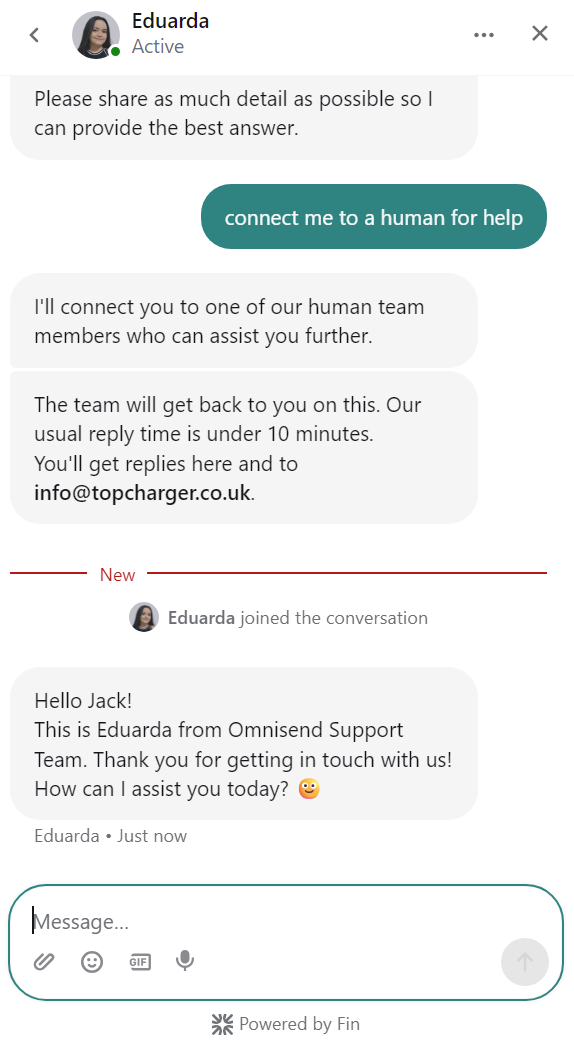
Winner
Draw. Omnisend and Klaviyo provide email and live chat support.
Response times and quality
Omnisend’s response times are excellent, to say the least. The chat widget above created a connection to a human assistant in under two minutes.
Email response times are typically less than two hours for critical issues, such as verification problems, and three hours for general questions.
Because live chat is available 24/7 in Omnisend, you can get set up and optimize your email marketing any time, every day of the week. The ability to ask questions and get answers fast means less searching for help centers and more getting stuff done.
Klaviyo’s response times are similar to Omnisend’s, but the level of support you receive depends on your plan. If you’re a free plan customer, you’re out of luck for email support after the first 60 days and can only chat with the virtual assistant.
You can expect to receive an email response from Klaviyo within six hours for critical issues and within 24 hours for any non-urgent questions.
Of course, your experience with response times and quality will be subjective for both Omnisend and Klaviyo, so don’t read too much into others’ reviews.
Winner
Omnisend. It provides 24/7 live chat and email support across all plans. Klaviyo’s support quality is just as good, but it’s available for fewer customers.
Learning resources
Omnisend’s Help Center includes a search bar and 500+ articles split into core learning categories, including onboarding, pricing and billing, integrations, audience management, deliverability, channels, automations, campaigns, segmenting your contacts, reports, and more:

Clicking any of those categories provides a list view of articles. The image below shows the contents for the onboarding category:

In addition to its Help Center, you can access Omnisend Academy for free, which includes 100+ YouTube videos covering many of the same topics.
Klaviyo also provides a Help Center with a search bar, but unlike Omnisend, it includes both Help Center and Academy articles in one view:
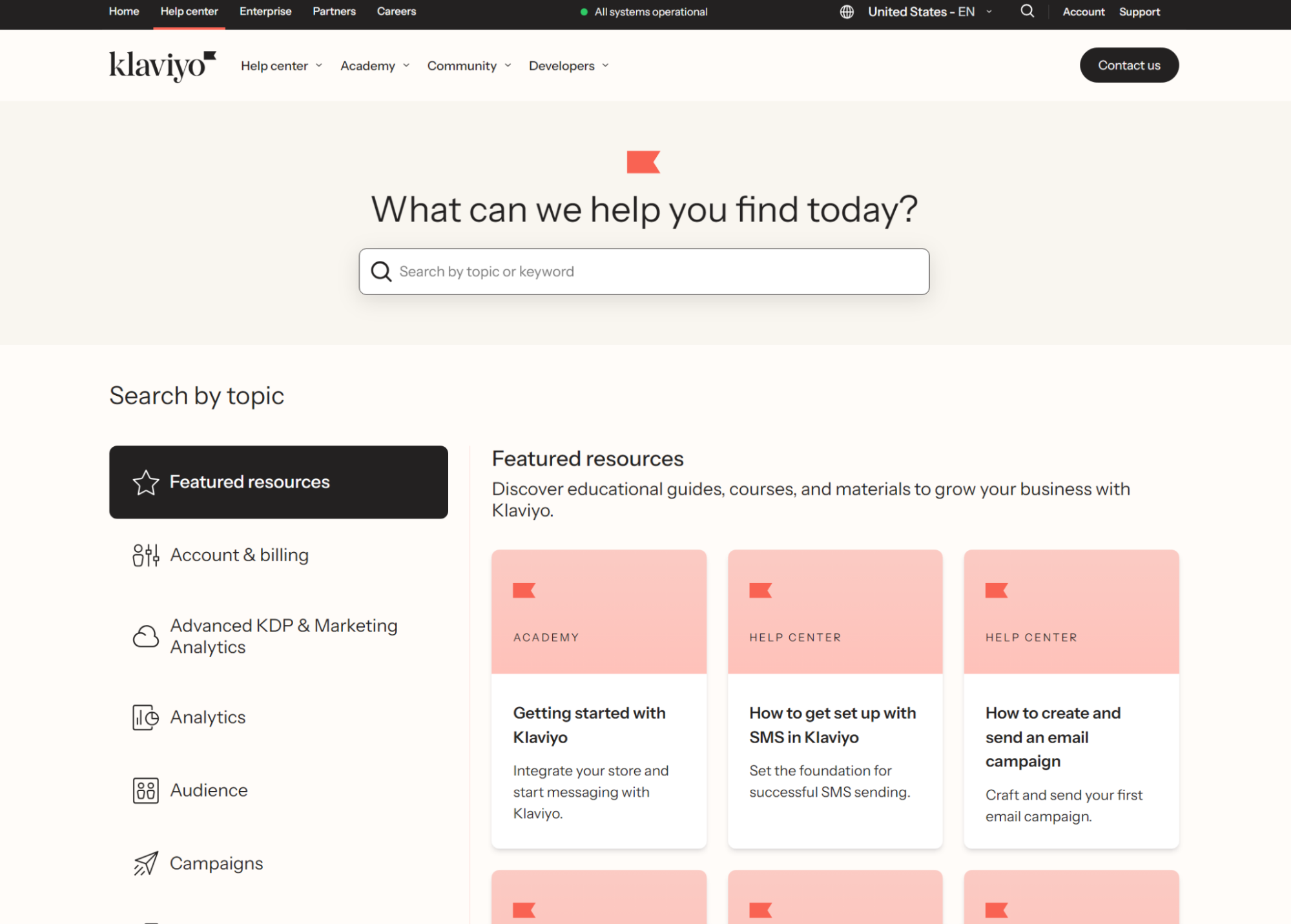
The navigation differs from Omnisend’s, with a sidebar for topics rather than a grid, although selecting a category opens up a grid view of sub-topics:
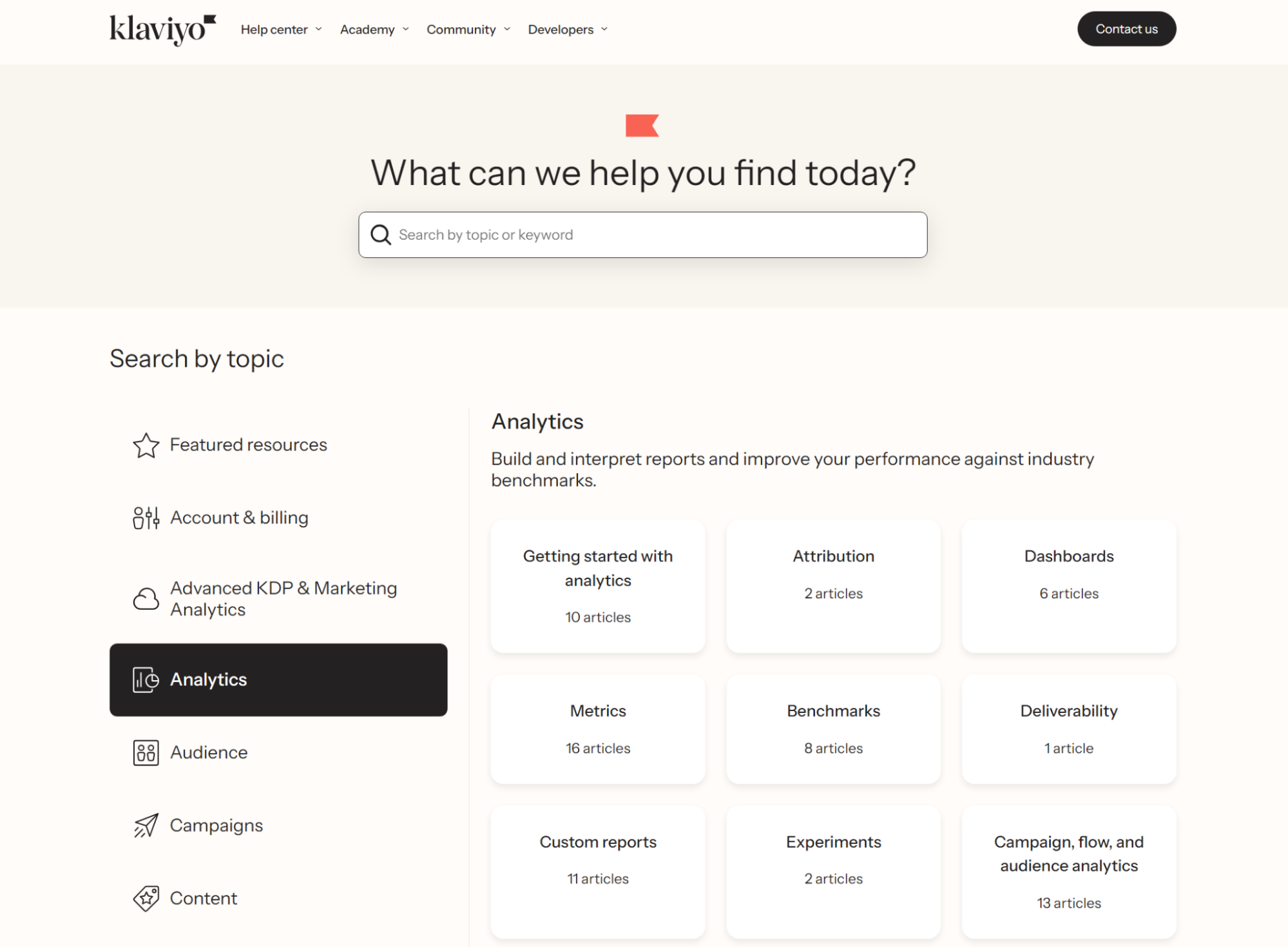
There are more steps to finding topics in Klaviyo than in Omnisend, although the quality of resources is on par in both. Klaviyo has fewer video resources, so if you’re a visual learner, you’ll prefer Omnisend’s approach.
Winner
Omnisend. Its Academy includes easily accessible videos, and its Help Center lets you access articles within two steps (click the category, select a topic).
What do real users say about each platform?
This Omnisend vs. Klaviyo comparison isn’t complete without user reviews. After all, people who use these platforms are the best judges of their performance.
Platform score comparisons
See what customers have to say about Omnisend and Klaviyo:
| Platform | Omnisend | Klaviyo |
|---|---|---|
| Shopify App Store | 4.8/5 (2,815 reviews) ⭐ | 4.7/5 (2,560 reviews) |
| WordPress | 4.8/5 (149 reviews) ⭐ | 2.9/5 (23 reviews) |
| Trustpilot | 4.4/5 (409 reviews) ⭐ | 2.1/5 (313 reviews) |
| G2 | 4.6/5 (1,051 reviews) | 4.6/5 (1,121 reviews) |
| Capterra | 4.7/5 (8232 reviews) ⭐ | 4.6/5 (506 reviews) |
Both platforms enjoy high ratings on the Shopify App Store, indicating strong satisfaction among Shopify merchants. On WordPress, Omnisend leads with a 4.8 rating.
The winner
Omnisend has better ratings. It outperforms Klaviyo on Trustpilot, scoring 4.4/5 compared to Klaviyo’s significantly lower rating of 2.1/5. On G2, both platforms are evenly rated at 4.6/5. Meanwhile, on Capterra, Omnisend holds a slight advantage, scoring 4.7/5, compared to Klaviyo’s 4.6/5.
What users love about each platform
Overall, Omnisend has higher ratings and more positive customer reviews. Here’s what a user has to say about Omnisend:
On the other hand, users on Shopify praise Klaviyo’s support and email campaign, and automation features:

Similarly, on G2, users have praised Omnisend for its comprehensive customer support. Here’s what a user had to say:

Klaviyo has also received good reviews for its comprehensive analytics and reporting features for marketing campaigns:

Winner
Omnisend wins on user reviews. Higher ratings across most platforms, especially the significant gaps on WordPress and Trustpilot, indicate greater overall customer satisfaction.
How easy is it to migrate from Klaviyo to Omnisend?
Very easy, with most migrations taking one day by yourself or if you use Omnisend’s free migration package valued at $1,000.
What data transfers from Klaviyo to Omnisend?
Your contacts’ information, including email addresses, phone numbers, names, addresses, subscription statuses, and consent records, is transferred over via Omnisend’s Klaviyo Data Import Tool.
Custom properties transfer with a “klaviyo_” prefix added. Omnisend’s import tool also brings segment criteria, opt-in dates, and the last active date.
Automation flows stay behind because Klaviyo uses a proprietary flow builder. You’ll build new ones in Omnisend using its template library for common ecommerce scenarios, such as welcome series.
The step-by-step migration process
Migrate to Omnisend with this workflow:
- Connect your store to Omnisend
Your customer data, products, and orders sync automatically once connected. Don’t close your Klaviyo account yet.
- Set up the Klaviyo Data Import Tool
Log in to Klaviyo and get an API key, drop it into Omnisend’s import tool, and your contacts will start transferring 500 at a time.
- Export and import segments
Export key segments from Klaviyo, such as engaged contacts, VIP customers, and SMS subscribers. Import them manually into Omnisend.
- Rebuild your workflows
Use Omnisend’s pre-built templates and flow builder to recreate your customer experiences. Test each workflow with the Trigger Preview Tool before going live.
- Warm up your sender reputation.
Start by emailing your most engaged contacts first to build your reputation with Omnisend and improve deliverability before sending to your complete list.
The illustration below provides a visual workflow you can use to migrate:
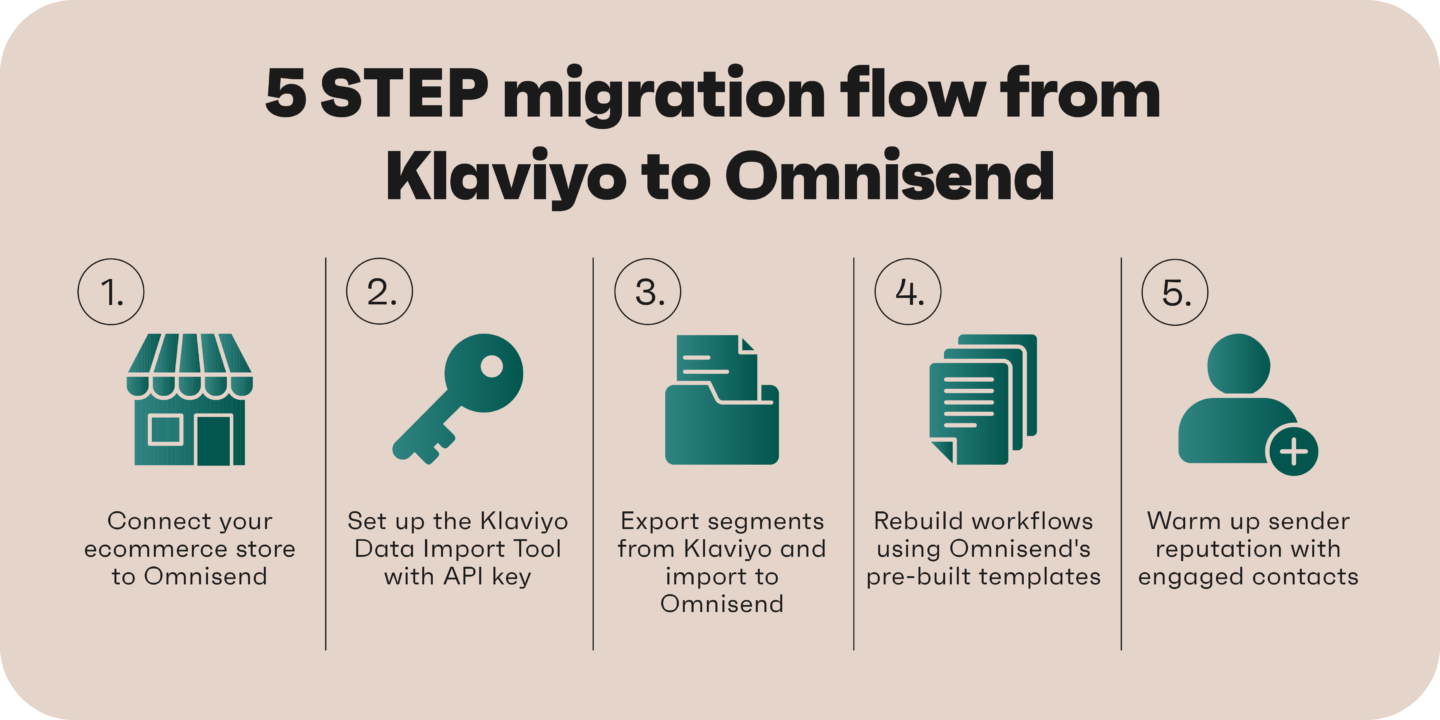
Migration support
Omnisend offers free Klaviyo migration with a Kickstart service that includes:
- Three workflow recreations (welcome series, abandoned cart, and one custom choice)
- Five-segment builds
- Three signup forms
- One master email template clone
- SMS toll-free number verification
This service could cover all your migration requirements if you’re a relatively new Klaviyo customer. Otherwise, it’ll give you a head start.
Migration timeline and business continuity
Contact import speed runs at 500 contacts every five seconds via Omnisend’s Klaviyo Data Import Tool. Therefore, if you’re on a free plan with 250 contacts, syncing takes seconds, and at 1,000 contacts, you’re looking at approximately 10 seconds.
You can continue sending emails from Klaviyo during the migration, as contact syncing doesn’t require shutting down your existing account.
It’s best practice to run both tools simultaneously while recreating and testing workflows and warming up your list, a parallel approach that allows you to verify everything works.
Once deliverability looks solid and workflows fire correctly, gradually shift your full email operations from Klaviyo to Omnisend. Don’t close your Klaviyo account until you’ve confirmed everything runs smoothly.
 |
Migration success story Rachel Riley switched from Klaviyo to Omnisend and saw a 77% year-over-year increase in BFCM revenue. Omnisend generated 48% of total store revenue during BFCM, with automations accounting for 46% of that. |
Omnisend vs. Klaviyo: Which should you choose?
Both platforms will help you send emails and grow your sales. The question is whether you value speed and simplicity or deeper control and customization.
Here are our final thoughts, based on everything we’ve discussed:
Choose Omnisend if
You’re an ecommerce store of any size wanting to build an omnichannel marketing strategy across email, SMS, and push notifications without a significant learning curve.
Omnisend’s app integrations, pre-built flows and segments, AI features, 24/7 support, and Academy provide you with the tools to master all channels. It’s also more affordable than Klaviyo across paid plans and doesn’t restrict the features of the free plan.
Choose Klaviyo if
You want more control over segmentation and need detailed reporting on what’s generating your revenue across channels.
Klaviyo’s advanced filters let you drill into customer behavior deeper than Omnisend and build unique flows and segments. 350+ integrations surpass Omnisend’s 160+, and its built-in CRM syncs with Salesforce if needed.
Still unsure? Try this
Sign up for a free account with both tools and explore their dashboards. At this stage, you don’t need to upload your contact lists, but you should connect your store so that you have complete access to their flow and segment builders.
If you’re already a Klaviyo customer, Omnisend provides a free migration service, which includes contacts, flows, five segments, three forms, and one master email template. It’s valued at $1,000 and makes switching hassle-free.
Omnisend unifies your email, SMS, and push channels, helping you maximize sales across the customer journey
Quick sign up | No credit card required
FAQs
Is Klaviyo worth paying more for if you run a small business?
In most cases, the answer’s no, because you could end up paying extra for advanced segmentation, flow, and reporting tools you won’t use. Omnisend costs less and provides the essential tools you need for your ecommerce business.
Which email platform is easier to learn?
Both tools have intuitive dashboards and high-quality documentation, but Klaviyo has more features to master. Omnisend has a smaller learning curve and provides 100+ tutorial videos in its Academy that you can access for free.
Will I lose data switching from Klaviyo to Omnisend?
No. Your contacts, automations, segments, forms, and main email template all transfer over. It takes approximately a day, and Omnisend’s team can assist you with this process.
Does one platform get better inbox placement than the other?
Neither one is better. Deliverability depends on both your sending reputation and the content of your emails.
Does Klaviyo integrate with Shopify Plus better than Omnisend?
No. Both pull the same data from Shopify Plus. There’s no difference in how they connect or what information they access from your store.
Do I need coding skills to use either platform?
Yes, if you’re building custom API connections to ecommerce platforms (and apps) that don’t have pre-built integrations. Otherwise, no.
This article was researched and written by our experts following a precise process.


